| Category of Scheme |
Multi Cap Fund |
Small Cap Fund |
Mid Cap Fund |
Focused Fund |
Value |
Large & Mid Cap Fund |
Thematic |
Thematic |
Thematic – Quant |
Flexi Cap |
Large Cap |
Dynamic Asset Allocation |
Business Cycle |
Thematic |
Thematic |
Thematic |
Thematic |
Thematic |
Thematic |
Thematic |
Thematic |
ELSS |
Aggressive Hybrid Fund |
Multi Asset Allocation |
Liquid Fund |
Overnight Fund |
Gilt Fund |
| Type of Scheme |
An open ended equity scheme investing across large cap, mid cap, small cap Companies |
An open ended equity scheme investing in Small Cap portfolio of Equity Shares. |
An open ended equity scheme investing in Mid Cap Companies.
|
An open ended equity scheme investing in maximum 30 large cap stocks. |
An open ended equity scheme investing in a well-diversified portfolio of value stocks |
An open ended equity scheme investing across Large & Mid Cap Companies |
An open ended equity scheme investing in the companies of Infrastructure sector |
An Open ended equity scheme investing in companies demonstrating sustainable practices across Environment, Social and Governance (ESG) theme. |
An open ended Equity Scheme investing based on a quant model theme.
|
An open ended dynamic equity scheme investing across large cap, mid cap, small cap stocks |
An open ended equity scheme investing across Large Cap Companies
|
An Open Ended Dynamic Asset Allocation Fund |
An open-ended equity scheme following business cycles based investing theme |
An open ended equity scheme investing in banking and financial services related sectors |
An open ended equity scheme investing in healthcare sector |
An open ended equity scheme following manufacturing theme. |
An open ended equity scheme investing in technology-centric companies
|
An open ended equity scheme following momentum theme |
An open ended equity scheme investing in commodity and commodity related sectors |
An open ended equity scheme following consumption theme
|
An open ended equity scheme investing in PSU/PSU subsidiaries sector. |
An open ended equity linked saving scheme with a statutory lock in of 3 years and tax
benefit
|
An open ended hybrid scheme investing predominantly in equity and equity related instruments. |
An open ended scheme investing in equity, debt and commodity.
|
An open-ended Liquid Scheme |
An open ended Debt Scheme investing in Overnight securities
|
An open ended debt scheme investing in government securities across maturity. |
| Scheme Risk-O-Meter |
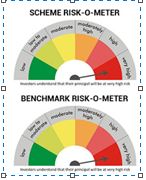 |
 |
 |
 |
 |
 |
 |
 |
 |
 |
 |
 |
 |
 |
 |
 |
 |
 |
 |
 |
 |
 |
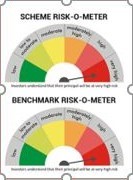 |
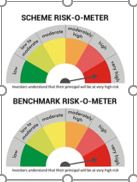 |
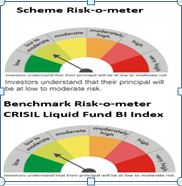 |
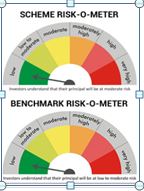 |
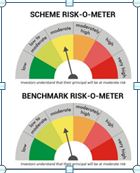 |
| Benchmark Index |
NIFTY 500 MULTICAP 50:25:25 TRI |
NIFTY SMALL CAP 250 TRI |
NIFTY MIDCAP 150 TRI |
NIFTY 500 TRI |
NIFTY 500 TRI |
Nifty Large Midcap 250 TRI |
Nifty Infrastructure TRI |
Nifty 100 ESG TRI |
NIFTY 200 TRI |
NIFTY 500 TRI |
NIFTY 100 TRI |
NIFTY 50 Hybrid Composite debt 50:50 Index |
NSE 500 TRI |
Nifty Financial Services TRI |
NIFTY Healthcare TRI |
Nifty India Manufacturing Index |
NIFTY IT TRI |
NIFTY 500 TRI |
Nifty Commodities TRI |
NIFTY India Consumption TRI |
NIFTY PSE TRI |
NIFTY 500 TRI |
NIFTY 50 Hybrid Composite Debt 65:35 Index |
65% BSE 200 TRI + 15% CRISIL Short Term Bond Fund Index + 20% iCOMDEX Composite Index |
CRISIL LIQUID FUND A1 INDEX |
CRISIL overnight Index |
CRISIL Dynamic Gilt Index |
| Investment Objective |
The primary investment objective of the scheme is to seek to generate capital appreciation & provide long-term growth opportunities by investing in a portfolio of Large Cap, Mid Cap and Small Cap companies. There is no assurance that the investment objective of the Scheme will be realized. |
The primary investment objective of the scheme is to seek to generate capital appreciation & provide long-term growth opportunities by investing in a portfolio of Small Cap companies. There is no assurance that the investment objective of the Scheme will be realized. |
The primary investment objective of the scheme is to generate capital appreciation &provide long-term growth opportunities by investing in a portfolio of Mid Cap companies.There is no assurance that the investment objective of the Scheme will be achieved.
|
The primary investment objective of the scheme is to seek to generate capital appreciation & provide long-term growth opportunities by investing in a focused portfolio of Large Cap – ‘blue chip’ – companies. There is no assurance that the investment objective of the Scheme will be realized. |
The primary investment objective of the scheme is to seek to achieve capital appreciation in the long-term by primarily investing in a well-diversified portfolio of value stocks. The AMC will have the discretion to completely or partially invest in any of the type of securities stated above with a view to maximize the returns or on defensive considerations. However, there can be no assurance that the investment objective of the Scheme will be realized, as actual market movements may be at variance with anticipated trends. |
The primary investment objective of the scheme is to seek to generate capital appreciation & provide long-term growth opportunities by investing in a portfolio of Large Cap and Mid Cap companies. There is no assurance that the investment objective of the Scheme will be realized. |
The primary investment objective of the scheme is to seek to generate capital appreciation & provide long-term growth opportunities by investing in a portfolio of Infrastructure focused companies. There is no assurance that the investment objective of the Scheme will be realized. |
To generate long term capital appreciation by investing in a diversified portfolio of companies demonstrating sustainable practices across Environmental, Social and Governance (ESG) parameters. However, there can be no assurance that the investment objective of the Scheme will be achieved. |
The investment objective of the Scheme is to deliver superior returns as compared to the underlying benchmark over the medium to long term through investing in equity and equity related securities. The portfolio of stocks will be selected, weighed and rebalanced using stock screeners, factor based scoring and an optimization formula which aims to enhance portfolio exposures to factors representing „good investing principles‟ such as growth, value and quality within risk constraints. However, there can be no assurance that the investment objective of the scheme will be realized. |
The primary investment objective of the scheme is to generate consistent returns by investing in a portfolio of Large Cap, Mid Cap and Small Cap companies. The AMC will have thediscretion to completely or partially invest in any of the type of securities stated above with aview to maximize the returns or on defensive considerations. However, there can be noassurance that the investment objective of the Scheme will be realized, as actual market movements may be at variance with anticipated trends |
The primary investment objective of the scheme is to seek to generate consistent by investing in equity and equity related instruments falling under the category of large cap companies. The AMC will have the discretion to completely or partially invest in any of the type of securities stated above with a view to maximize the returns or on defensive considerations. However, there can be no assurance that the investment objective of the Scheme will be realized, as actual market movements may be at variance with anticipated trends. |
The primary investment objective of the scheme is to provide capital appreciation by investing in equity and equity related instruments including derivatives and debt and money market instruments. However, there can be no assurance that the investment objective of the Scheme will be realized, as actual market movements may be at variance with anticipated trends. |
To generate long-term capital appreciation by investing with focus on riding business cycles through allocation between sectors and stocks at different stages of business cycles. However, there is no assurance or guarantee that the investment objective of the Scheme will be achieved. The scheme does not assure or guarantee any returns. |
The primary investment objective of the scheme is to generate consistent returns by investing in equity and equity related instruments of banking and financial services. However, there is no assurance that the investment objective of the Scheme will be achieved. |
The investment objective of the scheme is to seek long term capital appreciation by investing in equity/equity related instruments of companies from the healthcare sector. However, there is no assurance or guarantee that the investment objective of the Scheme will be achieved. The Scheme does not assure or guarantee any returns. |
The primary objective of the scheme is to generate long term capital appreciation by investing in equity and equity related instruments of companies that follow the manufacturing theme. However, there is no assurance or guarantee that the investment objective of the Scheme will be achieved. The Scheme does not assure or guarantee any returns |
The primary investment objective of the scheme is to seek to generate consistent returns by investing in equity and equity related instruments of technology-centric companies. However, there can be no assurance that the investment objective of the Scheme will be realized, as actual market movements may be at variance with anticipated trends. |
The primary investment objective of the scheme is to achieve long-term capital appreciation for its investors. This objective will be pursued by strategically investing in a diversified portfolio of equity and equity-related instruments. The selection of these instruments will be based on a quantitative model meticulously designed to identify potential investment opportunities that exhibit the potential for significant capital appreciation over the specified investment horizon. There is no assurance that the investment objective of the Scheme will be realized. |
The objective of the scheme is to generate long-term capital appreciation by creating a portfolio that is invested predominantly in Equity and Equity related securities of companies engaged in commodity and commodity related sectors. There is no assurance that the investment objective of the Scheme will be realized. |
The primary investment objective of the scheme is to generate capital appreciation & provide long-term growth opportunities by investing in a portfolio of Consumption driven companies. There is no assurance that the investment objective of the Scheme will be realized. |
The objective of the scheme is to generate long term capital appreciation by investing predominantly in equity and equity related securities of Public Sector Undertakings (PSUs). There is no assurance that the investment objective of the Scheme will be realized. |
The investment objective of the Scheme is to generate Capital Appreciation by investing predominantly in a well diversified portfolio of Equity Shares with growth potential. This income may be complemented by possible dividend and other income. |
The investment objective of the scheme is to generate income/capital appreciation by investing primarily in equity and equity related instruments with a moderate exposure to debt securities & money market instruments. There is no assurance that the investment objective of the Scheme will be realized. |
The investment objective of the scheme is to generate capital appreciation & provide longterm growth opportunities by investing in instruments across the three asset classes viz.
Equity, Debt and Commodity. There is no assurance that the investment objective of the
Scheme will be realized.
|
The investment objective of the scheme is to generate income through a portfolio comprising money market and debt instruments. There is no assurance that the investment objective of the Scheme will be realized. |
The investment objective of the scheme is to generate returns by investing in debt and money market instruments with overnight maturity. However, there can be no assurance that the investment objective of the Scheme will be realized. |
To generate returns through investments in sovereign securities issued by the Central Government and/or State Government. However, there can be no assurance that the investment objective of the Scheme will be realized. |
| Asset Allocation Pattern |
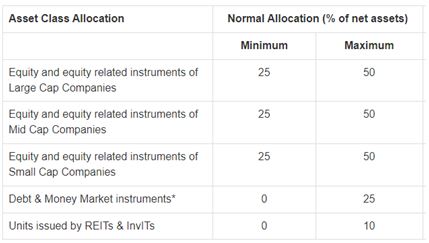 |
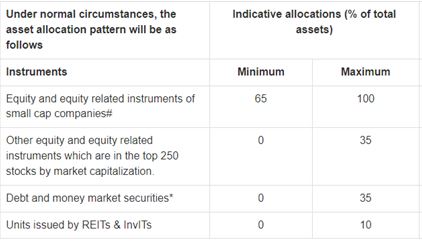 |
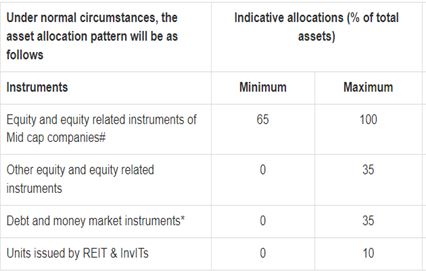 |
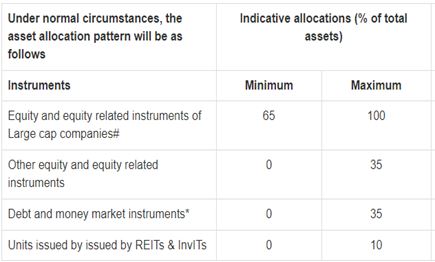 |
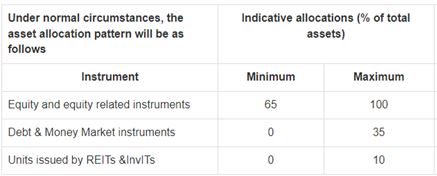 |
 |
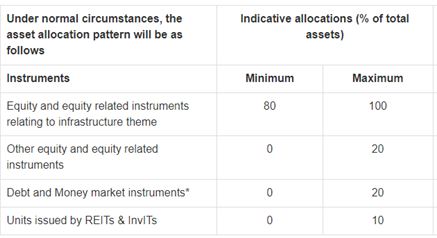 |
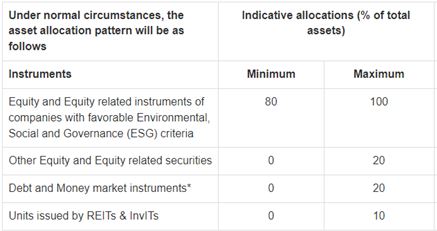 |
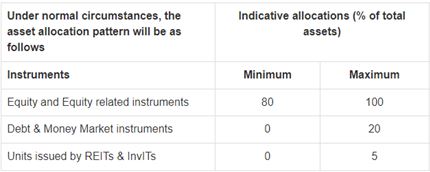 |
 |
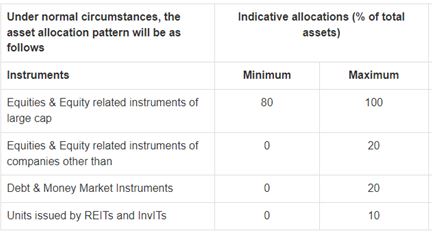 |
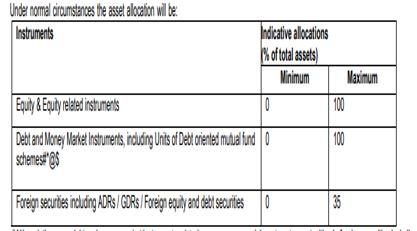 |
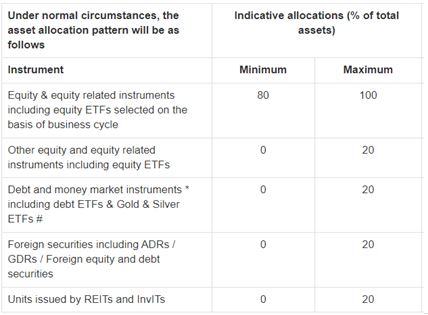 |
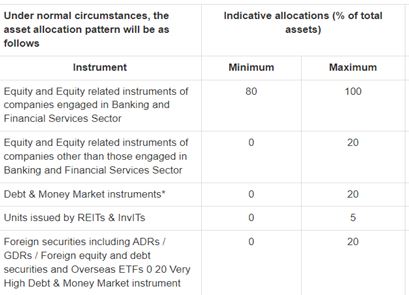 |
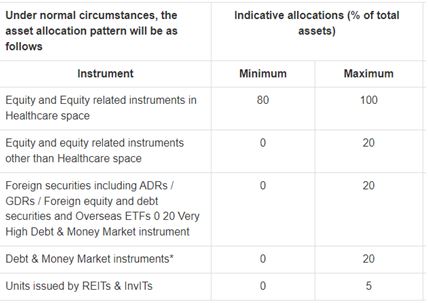 |
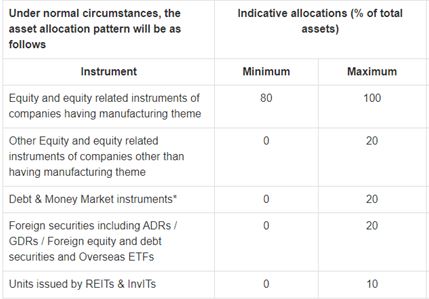 |
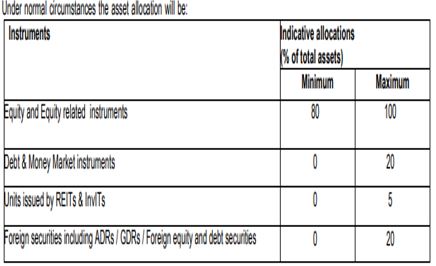 |
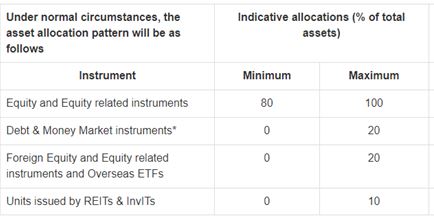 |
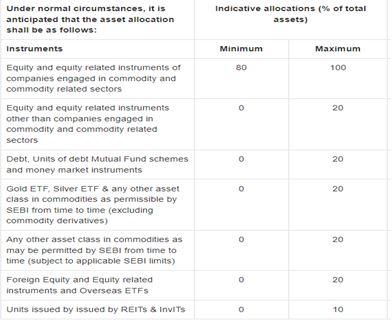 |
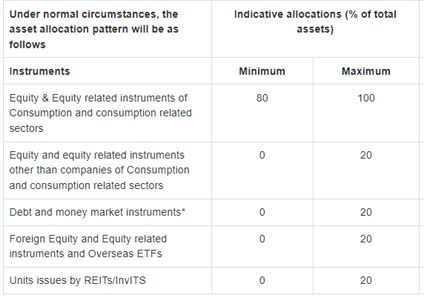 |
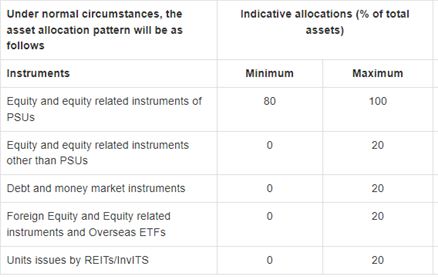 |
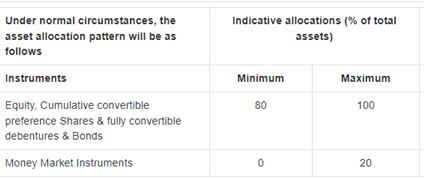 |
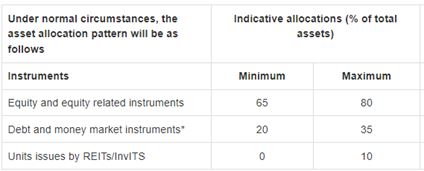 |
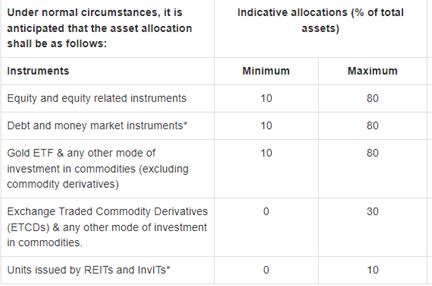 |
 |
 |
 |
| Lock-In Period |
Nil |
Nil |
Nil |
Nil |
Nil |
Nil |
Nil |
Nil |
Nil |
Nil |
Nil |
Nil |
Nil |
Nil |
Nil |
Nil |
Nil |
Nil |
Nil |
Nil |
Nil |
3 Years from the date of allotment of the respective Units. |
Nil |
Nil |
Nil |
Nil |
Nil |
| Exit Load |
Exit Load - 15 Days / 1% Effective from August 11, 2023 |
Exit Load : 1% if exit <= 1 Year |
Exit: 0.5% if exit <= 3 Months |
Exit Load - 15 Days / 1% Effective from August 11, 2023 |
Exit Load -15 Days / 1% Effective from August 11, 2023 |
Exit Load -15 Days / 1% Effective from August 11, 2023 |
Exit: 0.5% if exit <= 3 Months |
Exit Load - 15 Days / 1% Effective from August 11, 2023 |
Exit Load - 15 Days / 1% Effective from August 11 ,2023 |
Exit Load - 15 Days / 1% Effective from August 11 ,2023 |
Exit Load - 15 Days / 1% Effective from August 11 ,2023 |
Exit Load - 15 Days / 1% Effective from August 11 ,2023 |
Exit Load - 15 Days / 1% Effective from August 11 ,2023 |
Exit Load - 15 Days / 1% Effective from August 11 ,2023 |
Exit Load - 15 Days / 1% Effective from August 11 ,2023 |
Exit Load - 15 Days / 1% Effective from August 11 ,2023 |
Exit Load - 15 Days / 1% Effective from August 11 ,2023 |
Exit Load - 15 Days / 1% Effective from August 11 ,2023 |
Exit Load - 15 Days / 1% Effective from August 11 ,2023 |
Exit Load - 15 Days / 1% Effective from August 11 ,2023 |
Exit Load - 15 Days / 1% Effective from August 11 ,2023 |
- |
Exit Load - 15 Days / 1% Effective from August 11, 2023 |
Exit Load - 15 Days / 1% Effective from August 11, 2023 |
taggered Exit load for 6 days , from day 7 days onwards nil *Day 1 - 0.0070%", Day 2 - 0.0065%", Day 3 - 0.0060%", Day 4 - 0.0055%", Day 5 - 0.0050%", Day 6 - 0.0045%", Day 7 – Nil |
- |
- |
| Inception Date |
17-Apr-01 |
29-Oct-96 |
20-Mar-01 |
28-Aug-08 |
30-Nov-21 |
08-Jan-07 |
20-Sep-07 |
05-Nov-20 |
03-May-21 |
17-Oct-08 |
11-Aug-22 |
12-Apr-23 |
30-May-23 |
20-Jun-23 |
17-Jul-23 |
16th August, 2023 |
11th September, 2023 |
20th November, 2023 |
27th December, 2023 |
24th January, 2024 |
20th February, 2024 |
13-Apr-2000 |
17-Apr-01 |
17-Apr-01 |
03-Oct-05 |
04-Dec-22 |
21-Dec-22 |
| Minimum Application Amount |
For new investor, INR 5000/- and any amount thereafter\nFor existing investors, INR 1000/- and any amount thereafter\nFor Systematic Investment Plan (SIP), the minimum amount is INR 1000/- and in multiples of INR 1/- thereafter. |
For new investor, INR 5000/- and any amount thereafter\nFor existing investors, INR 1000/- and any amount thereafter\nFor Systematic Investment Plan (SIP), the minimum amount is INR 1000/- and in multiples of INR 1/- thereafter. |
For new investor, INR 5000/- and any amount thereafter\nFor existing investors, INR 1000/- and any amount thereafter\nFor Systematic Investment Plan (SIP), the minimum amount is INR 1000/- and in multiples of INR 1/- thereafter. |
For new investor, INR 5000/- and any amount thereafter\nFor existing investors, INR 1000/- and any amount thereafter\nFor Systematic Investment Plan (SIP), the minimum amount is INR 1000/- and in multiples of INR 1/- thereafter. |
For new investor, INR 5000/- and any amount thereafter\nFor existing investors, INR 1000/- and any amount thereafter\nFor Systematic Investment Plan (SIP), the minimum amount is INR 1000/- and in multiples of INR 1/- thereafter. |
For new investor, INR 5000/- and any amount thereafter\nFor existing investors, INR 1000/- and any amount thereafter\nFor Systematic Investment Plan (SIP), the minimum amount is INR 1000/- and in multiples of INR 1/- thereafter. |
For new investor, INR 5000/- and any amount thereafter\nFor existing investors, INR 1000/- and any amount thereafter\nFor Systematic Investment Plan (SIP), the minimum amount is INR 1000/- and in multiples of INR 1/- thereafter. |
For new investor, INR 5000/- and any amount thereafter\nFor existing investors, INR 1000/- and any amount thereafter\nFor Systematic Investment Plan (SIP), the minimum amount is INR 1000/- and in multiples of INR 1/- thereafter. |
For new investor, INR 5000/- and any amount thereafter\nFor existing investors, INR 1000/- and any amount thereafter\nFor Systematic Investment Plan (SIP), the minimum amount is INR 1000/- and in multiples of INR 1/- thereafter. |
For new investor, INR 5000/- and any amount thereafter\nFor existing investors, INR 1000/- and any amount thereafter\nFor Systematic Investment Plan (SIP), the minimum amount is INR 1000/- and in multiples of INR 1/- thereafter. |
For new investor, INR 5000/- and any amount thereafter\nFor existing investors, INR 1000/- and any amount thereafter\nFor Systematic Investment Plan (SIP), the minimum amount is INR 1000/- and in multiples of INR 1/- thereafter. |
For new investor, INR 5000/- and any amount thereafter\nFor existing investors, INR 1000/- and any amount thereafter\nFor Systematic Investment Plan (SIP), the minimum amount is INR 1000/- and in multiples of INR 1/- thereafter. |
For new investor, INR 5000/- and any amount thereafter\nFor existing investors, INR 1000/- and any amount thereafter\nFor Systematic Investment Plan (SIP), the minimum amount is INR 1000/- and in multiples of INR 1/- thereafter. |
For new investor, INR 5000/- and any amount thereafter\nFor existing investors, INR 1000/- and any amount thereafter\nFor Systematic Investment Plan (SIP), the minimum amount is INR 1000/- and in multiples of INR 1/- thereafter. |
For new investor, INR 5000/- and any amount thereafter\nFor existing investors, INR 1000/- and any amount thereafter\nFor Systematic Investment Plan (SIP), the minimum amount is INR 1000/- and in multiples of INR 1/- thereafter. |
For new investor, INR 5000/- and any amount thereafter\nFor existing investors, INR 1000/- and any amount thereafter\nFor Systematic Investment Plan (SIP), the minimum amount is INR 1000/- and in multiples of INR 1/- thereafter. |
For new investor, INR 5000/- and any amount thereafter\nFor existing investors, INR 1000/- and any amount thereafter\nFor Systematic Investment Plan (SIP), the minimum amount is INR 1000/- and in multiples of INR 1/- thereafter. |
For new investor, INR 5000/- and any amount thereafter\nFor existing investors, INR 1000/- and any amount thereafter\nFor Systematic Investment Plan (SIP), the minimum amount is INR 1000/- and in multiples of INR 1/- thereafter. |
For new investor, INR 5000/- and any amount thereafter\nFor existing investors, INR 1000/- and any amount thereafter\nFor Systematic Investment Plan (SIP), the minimum amount is INR 1000/- and in multiples of INR 1/- thereafter. |
For new investor, INR 5000/- and any amount thereafter\nFor existing investors, INR 1000/- and any amount thereafter\nFor Systematic Investment Plan (SIP), the minimum amount is INR 1000/- and in multiples of INR 1/- thereafter. |
For new investor, INR 5000/- and any amount thereafter\nFor existing investors, INR 1000/- and any amount thereafter\nFor Systematic Investment Plan (SIP), the minimum amount is INR 1000/- and in multiples of INR 1/- thereafter. |
For new investor, INR 500/- and any amount thereafter\nFor existing investors, INR 500/- and any amount thereafter\nFor Systematic Investment Plan (SIP), the minimum amount is INR 500/- and in multiples of INR 1/- thereafter. |
For new investor, INR 5000/- and any amount thereafter\nFor existing investors, INR 1000/- and any amount thereafter\nFor Systematic Investment Plan (SIP), the minimum amount is INR 1000/- and in multiples of INR 1/- thereafter. |
For new investor, INR 5000/- and any amount thereafter\nFor existing investors, INR 1000/- and any amount thereafter\nFor Systematic Investment Plan (SIP), the minimum amount is INR 1000/- and in multiples of INR 1/- thereafter. |
For new investor, INR 5000/- and any amount thereafter\nFor existing investors, INR 1000/- and any amount thereafter\nFor Systematic Investment Plan (SIP), the minimum amount is INR 1000/- and in multiples of INR 1/- thereafter. |
For new investor, INR 5000/- and any amount thereafter\nFor existing investors, INR 1000/- and any amount thereafter\nFor Systematic Investment Plan (SIP), the minimum amount is INR 1000/- and in multiples of INR 1/- thereafter. |
For new investor, INR 5000/- and any amount thereafter\nFor existing investors, INR 1000/- and any amount thereafter\nFor Systematic Investment Plan (SIP), the minimum amount is INR 1000/- and in multiples of INR 1/- thereafter. |
| Fund Manager |
Mr. Sandeep Tandon, Mr. Ankit Pande, Mr. Lokesh Garg , Mr. Varun Pattani, Ms. Ayusha Kumbhat, Mr. Yug Tibrewal, Mr.Sameer Kate, Mr. Sanjeev Sharma |
Mr. Sandeep Tandon, Mr. Ankit Pande, Mr. Varun Pattani , Ms. Ayusha Kumbhat , Mr.Yug Tibrewal, Mr.Sameer Kate, Mr. Sanjeev Sharma |
Mr. Sandeep Tandon, Mr. Ankit Pande,Mr. Varun Pattani , Ms. Ayusha Kumbhat, Mr. Yug Tibrewal, Mr.Sameer Kate, Mr. Sanjeev Sharma |
Mr. Sandeep Tandon, Mr. Ankit Pande,Mr.Lokesh Garg, Mr. Varun Pattani , Ms. Ayusha Kumbhat, Mr. Yug Tibrewal, Mr.Sameer Kate, Mr. Sanjeev Sharma |
Mr. Sandeep Tandon, Mr. Ankit Pande,Mr. Varun Pattani , Ms. Ayusha Kumbhat, Mr. Yug Tibrewal, Mr.Sameer Kate, Mr. Sanjeev Sharma |
Mr. Sandeep Tandon, Mr. Ankit Pande,Mr. Varun Pattani , Ms. Ayusha Kumbhat, Mr. Yug Tibrewal, Mr.Sameer Kate, Mr. Sanjeev Sharma |
Mr.Sandeep Tandon, Mr.Ankit Pande, Mr. Lokesh Garg, Ms.Ayusha Kumbhat, Mr.Varun Pattani, Mr.Yug Tibrewal, Mr.Sameer Kate, Mr.Sanjeev Sharma |
Mr. Sandeep Tandon, Mr. Ankit Pande,Mr. Varun Pattani , Ms. Ayusha Kumbhat, Mr. Yug Tibrewal, Mr.Sameer Kate, Mr. Sanjeev Sharma |
Mr. Sandeep Tandon, Mr. Ankit Pande,Mr. Varun Pattani , Ms. Ayusha Kumbhat, Mr. Yug Tibrewal, Mr.Sameer Kate, Mr. Sanjeev Sharma |
Mr.Sandeep Tandon, Mr.Ankit Pande,Mr. Lokesh Garg, Mr.Varun Pattani, Ms.Ayusha Kumbhat, Mr.Yug Tibrewal, Mr.Sameer Kate, Mr. Sanjeev Sharma |
Mr.Sandeep Tandon, Mr.Ankit Pande,Mr. Lokesh Garg, Mr.Varun Pattani, Ms.Ayusha Kumbhat, Mr.Yug Tibrewal, Mr.Sameer Kate,Mr. Sanjeev Sharma |
Mr.Sandeep Tandon,Mr. Ankit Pande, Mr.Sameer Kate,Mr.Varun Pattani, Ms.Ayusha Kumbhat, Mr.Yug Tibrewal, Mr. Sanjeev Sharma |
Mr. Sandeep Tandon, Mr. Ankit Pande, Mr.Lokesh Garg,Mr.Varun Pattani, Ms.Ayusha Kumbhat, Mr.Yug Tibrewal, Mr.Sameer Kate, Mr.Sanjeev Sharma |
Mr. Sandeep Tandon, Mr. Ankit Pande, Mr.Varun Pattani, Ms. Ayusha Kumbhat,Mr.Yug Tibrewal, Mr.Sameer Kate, Mr. Sanjeev Sharma |
Mr. Sandeep Tandon, Mr. Ankit Pande, Mr.Varun Pattani ,Ms.Ayusha Kumbhat, Mr.Yug Tibrewal, Mr. Sameer Kate, Mr. Sanjeev Sharma |
Mr. Sandeep Tandon, Mr. Ankit Pande, Mr.Varun Pattani, Mr.Lokesh Garg, Ms.Ayusha Kumbhat, Mr.Yug Tibrewal, Mr.Sameer Kate, Mr.Sanjeev Sharma |
Mr. Sandeep Tandon, Mr. Ankit Pande, Mr.Varun Pattani, Ms.Ayusha Kumbhat,Mr.Yug Tibrewal, Mr.Sameer Kate, Mr. Sanjeev Sharma |
Mr. Sandeep Tandon, Mr. Ankit Pande, Mr.Sameer Kate, Mr.Varun Pattani, Ms.Ayusha Kumbhat, Mr.Yug Tibrewal, Mr. Sanjeev Sharma |
Mr. Sandeep Tandon, Mr. Ankit Pande, Mr.Sameer Kate, Mr.Varun Pattani, Ms.Ayusha Kumbhat, Mr.Yug Tibrewal,Mr. Sanjeev Sharma |
Mr. Sandeep Tandon, Mr. Ankit Pande, Mr.Sameer Kate, Mr.Varun Pattani, Ms.Ayusha Kumbhat, Mr.Yug Tibrewal,Mr. Sanjeev Sharma |
Mr. Sandeep Tandon, Mr. Ankit Pande, Mr. Varun Pattani, Ms.Ayusha Kumbhat, Mr.Yug Tibrewal, Mr.Sameer Kate, Mr. Sanjeev Sharma |
Mr. Sandeep Tandon, Mr. Ankit Pande, Mr. Varun Pattani, Ms.Ayusha Kumbhat, Mr.Yug Tibrewal, Mr.Sameer Kate, Mr. Sanjeev Sharma |
Mr. Sandeep Tandon, Mr. Ankit Pande, Mr. Lokesh Garg, Mr.Varun Pattani, Ms.Ayusha Kumbhat, Mr.Yug Tibrewal, Mr.Sameer Kate, Mr. Sanjeev Sharma |
Mr. Sandeep Tandon, Mr. Ankit Pande, Mr. Sameer Kate, Mr.Varun Pattani, Ms.Ayusha Kumbhat, Mr.Yug Tibrewal, Mr. Sanjeev Sharma |
Mr. Sanjeev Sharma, Mr. Harshvardhan Bharatia |
Mr. Sanjeev Sharma, Mr. Harshvardhan Bharatia |
Mr. Sanjeev Sharma, Mr. Harshvardhan Bharatia |
| Minimum Investment Amount |
5000 |
5000 |
5000 |
5000 |
5000 |
5000 |
5000 |
5000 |
5000 |
5000 |
5000 |
5000 |
5000 |
5000 |
5000 |
5000 |
5000 |
5000 |
5000 |
5000 |
5000 |
500 |
5000 |
5000 |
5000 |
5000 |
5000 |
| Minimum Investment for SIP |
1000 |
1000 |
1000 |
1000 |
1000 |
1000 |
1000 |
1000 |
1000 |
1000 |
1000 |
1000 |
1000 |
1000 |
1000 |
1000 |
1000 |
1000 |
1000 |
1000 |
1000 |
500 |
1000 |
1000 |
1000 |
1000 |
1000 |
| Plans Available |
Regular Plan and Direct Plan.\n(The Regular and Direct plan will have a common portfolio) |
Regular Plan and Direct Plan.\n(The Regular and Direct plan will have a common portfolio) |
Regular Plan and Direct Plan.\n(The Regular and Direct plan will have a common portfolio) |
Regular Plan and Direct Plan.\n(The Regular and Direct plan will have a common portfolio) |
Regular Plan and Direct Plan.\n(The Regular and Direct plan will have a common portfolio) |
Regular Plan and Direct Plan.\n(The Regular and Direct plan will have a common portfolio) |
Regular Plan and Direct Plan.\n(The Regular and Direct plan will have a common portfolio) |
Regular Plan and Direct Plan.\n(The Regular and Direct plan will have a common portfolio) |
Regular Plan and Direct Plan.\n(The Regular and Direct plan will have a common portfolio) |
Regular Plan and Direct Plan.\n(The Regular and Direct plan will have a common portfolio) |
Regular Plan and Direct Plan.\n(The Regular and Direct plan will have a common portfolio) |
Regular Plan and Direct Plan.\n(The Regular and Direct plan will have a common portfolio) |
Regular Plan and Direct Plan.\n(The Regular and Direct plan will have a common portfolio) |
Regular Plan and Direct Plan.\n(The Regular and Direct plan will have a common portfolio) |
Regular Plan and Direct Plan.\n(The Regular and Direct plan will have a common portfolio) |
Regular Plan and Direct Plan.\n(The Regular and Direct plan will have a common portfolio) |
Regular Plan and Direct Plan.\n(The Regular and Direct plan will have a common portfolio) |
Regular Plan and Direct Plan.\n(The Regular and Direct plan will have a common portfolio) |
Regular Plan and Direct Plan.\n(The Regular and Direct plan will have a common portfolio) |
Regular Plan and Direct Plan.\n(The Regular and Direct plan will have a common portfolio) |
Regular Plan and Direct Plan.\n(The Regular and Direct plan will have a common portfolio) |
Regular Plan and Direct Plan.\n(The Regular and Direct plan will have a common portfolio) |
Regular Plan and Direct Plan.\n(The Regular and Direct plan will have a common portfolio) |
Regular Plan and Direct Plan.\n(The Regular and Direct plan will have a common portfolio) |
Regular Plan and Direct Plan.\n(The Regular and Direct plan will have a common portfolio) |
Regular Plan and Direct Plan.\n(The Regular and Direct plan will have a common portfolio) |
Regular Plan and Direct Plan.\n(The Regular and Direct plan will have a common portfolio) |
| Options Available |
1.Growth Option and 2. IDCW\nThe IDCW option has the following facilities: (i) IDCW Reinvestment Facility. (ii) IDCW Pay-out Facility. Default Investment option is Growth Option. For the IDCW option, the default facility will be IDCW Reinvestment. |
1.Growth Option and 2. IDCW\nThe IDCW option has the following facilities: (i) IDCW Reinvestment Facility. (ii) IDCW Pay-out Facility. Default Investment option is Growth Option. For the IDCW option, the default facility will be IDCW Reinvestment. |
1.Growth Option and 2. IDCW\nThe IDCW option has the following facilities: (i) IDCW Reinvestment Facility. (ii) IDCW Pay-out Facility. Default Investment option is Growth Option. For the IDCW option, the default facility will be IDCW Reinvestment. |
1.Growth Option and 2. IDCW\nThe IDCW option has the following facilities: (i) IDCW Reinvestment Facility. (ii) IDCW Pay-out Facility. Default Investment option is Growth Option. For the IDCW option, the default facility will be IDCW Reinvestment. |
1.Growth Option and 2. IDCW\nThe IDCW option has the following facilities: (i) IDCW Reinvestment Facility. (ii) IDCW Pay-out Facility. Default Investment option is Growth Option. For the IDCW option, the default facility will be IDCW Reinvestment. |
1.Growth Option and 2. IDCW\nThe IDCW option has the following facilities: (i) IDCW Reinvestment Facility. (ii) IDCW Pay-out Facility. Default Investment option is Growth Option. For the IDCW option, the default facility will be IDCW Reinvestment. |
1.Growth Option and 2. IDCW\nThe IDCW option has the following facilities: (i) IDCW Reinvestment Facility. (ii) IDCW Pay-out Facility. Default Investment option is Growth Option. For the IDCW option, the default facility will be IDCW Reinvestment. |
1.Growth Option and 2. IDCW\nThe IDCW option has the following facilities: (i) IDCW Reinvestment Facility. (ii) IDCW Pay-out Facility. Default Investment option is Growth Option. For the IDCW option, the default facility will be IDCW Reinvestment. |
1.Growth Option and 2. IDCW\nThe IDCW option has the following facilities: (i) IDCW Reinvestment Facility. (ii) IDCW Pay-out Facility. Default Investment option is Growth Option. For the IDCW option, the default facility will be IDCW Reinvestment. |
1.Growth Option and 2. IDCW\nThe IDCW option has the following facilities: (i) IDCW Reinvestment Facility. (ii) IDCW Pay-out Facility. Default Investment option is Growth Option. For the IDCW option, the default facility will be IDCW Reinvestment. |
1.Growth Option and 2. IDCW\nThe IDCW option has the following facilities: (i) IDCW Reinvestment Facility. (ii) IDCW Pay-out Facility. Default Investment option is Growth Option. For the IDCW option, the default facility will be IDCW Reinvestment. |
1.Growth Option and 2. IDCW\nThe IDCW option has the following facilities: (i) IDCW Reinvestment Facility. (ii) IDCW Pay-out Facility. Default Investment option is Growth Option. For the IDCW option, the default facility will be IDCW Reinvestment. |
1.Growth Option and 2. IDCW\nThe IDCW option has the following facilities: (i) IDCW Reinvestment Facility. (ii) IDCW Pay-out Facility. Default Investment option is Growth Option. For the IDCW option, the default facility will be IDCW Reinvestment. |
1.Growth Option and 2. IDCW\nThe IDCW option has the following facilities: (i) IDCW Reinvestment Facility. (ii) IDCW Pay-out Facility. Default Investment option is Growth Option. For the IDCW option, the default facility will be IDCW Reinvestment. |
1.Growth Option and 2. IDCW\nThe IDCW option has the following facilities: (i) IDCW Reinvestment Facility. (ii) IDCW Pay-out Facility. Default Investment option is Growth Option. For the IDCW option, the default facility will be IDCW Reinvestment. |
1.Growth Option and 2. IDCW\nThe IDCW option has the following facilities: (i) IDCW Reinvestment Facility. (ii) IDCW Pay-out Facility. Default Investment option is Growth Option. For the IDCW option, the default facility will be IDCW Reinvestment. |
1.Growth Option and 2. IDCW\nThe IDCW option has the following facilities: (i) IDCW Reinvestment Facility. (ii) IDCW Pay-out Facility. Default Investment option is Growth Option. For the IDCW option, the default facility will be IDCW Reinvestment. |
1.Growth Option and 2. IDCW\nThe IDCW option has the following facilities: (i) IDCW Reinvestment Facility. (ii) IDCW Pay-out Facility. Default Investment option is Growth Option. For the IDCW option, the default facility will be IDCW Reinvestment. |
1.Growth Option and 2. IDCW\nThe IDCW option has the following facilities: (i) IDCW Reinvestment Facility. (ii) IDCW Pay-out Facility. Default Investment option is Growth Option. For the IDCW option, the default facility will be IDCW Reinvestment. |
1.Growth Option and 2. IDCW\nThe IDCW option has the following facilities: (i) IDCW Reinvestment Facility. (ii) IDCW Pay-out Facility. Default Investment option is Growth Option. For the IDCW option, the default facility will be IDCW Reinvestment. |
1.Growth Option and 2. IDCW\nThe IDCW option has the following facilities: (i) IDCW Reinvestment Facility. (ii) IDCW Pay-out Facility. Default Investment option is Growth Option. For the IDCW option, the default facility will be IDCW Reinvestment. |
1.Growth option and 2. IDCW The IDCW option has the following facilities:(1)IDCW Pay-out Facility Default. Investment Option is Growth For the IDCW option ,the default facility will be IDCW Pay-out |
1.Growth Option and 2. IDCW\nThe IDCW option has the following facilities: (i) IDCW Reinvestment Facility. (ii) IDCW Pay-out Facility. Default Investment option is Growth Option. For the IDCW option, the default facility will be IDCW Reinvestment. |
1.Growth Option and 2. IDCW\nThe IDCW option has the following facilities: (i) IDCW Reinvestment Facility. (ii) IDCW Pay-out Facility. Default Investment option is Growth Option. For the IDCW option, the default facility will be IDCW Reinvestment. |
1.Growth Option and 2. IDCW\nThe IDCW option has the following facilities: (i) IDCW Reinvestment Facility. (ii) IDCW Pay-out Facility. Default Investment option is Growth Option. For the IDCW option, the default facility will be IDCW Reinvestment. |
1.Growth Option and 2. IDCW\nThe IDCW option has the following facilities: (i) IDCW Reinvestment Facility. (ii) IDCW Pay-out Facility. Default Investment option is Growth Option. For the IDCW option, the default facility will be IDCW Reinvestment. |
1.Growth Option and 2. IDCW\nThe IDCW option has the following facilities: (i) IDCW Reinvestment Facility. (ii) IDCW Pay-out Facility. Default Investment option is Growth Option. For the IDCW option, the default facility will be IDCW Reinvestment. |
| Applicable NAV |
The NAV applicable for purchase or redemption or switching of Units based on the time of the Business Day on which the application is time stamped. |
The NAV applicable for purchase or redemption or switching of Units based on the time of the Business Day on which the application is time stamped. |
The NAV applicable for purchase or redemption or switching of Units based on the time of the Business Day on which the application is time stamped. |
The NAV applicable for purchase or redemption or switching of Units based on the time of the Business Day on which the application is time stamped. |
The NAV applicable for purchase or redemption or switching of Units based on the time of the Business Day on which the application is time stamped. |
The NAV applicable for purchase or redemption or switching of Units based on the time of the Business Day on which the application is time stamped. |
The NAV applicable for purchase or redemption or switching of Units based on the time of the Business Day on which the application is time stamped. |
The NAV applicable for purchase or redemption or switching of Units based on the time of the Business Day on which the application is time stamped. |
The NAV applicable for purchase or redemption or switching of Units based on the time of the Business Day on which the application is time stamped. |
The NAV applicable for purchase or redemption or switching of Units based on the time of the Business Day on which the application is time stamped. |
The NAV applicable for purchase or redemption or switching of Units based on the time of the Business Day on which the application is time stamped. |
The NAV applicable for purchase or redemption or switching of Units based on the time of the Business Day on which the application is time stamped. |
The NAV applicable for purchase or redemption or switching of Units based on the time of the Business Day on which the application is time stamped. |
The NAV applicable for purchase or redemption or switching of Units based on the time of the Business Day on which the application is time stamped. |
The NAV applicable for purchase or redemption or switching of Units based on the time of the Business Day on which the application is time stamped. |
The NAV applicable for purchase or redemption or switching of Units based on the time of the Business Day on which the application is time stamped. |
The NAV applicable for purchase or redemption or switching of Units based on the time of the Business Day on which the application is time stamped. |
The NAV applicable for purchase or redemption or switching of Units based on the time of the Business Day on which the application is time stamped. |
The NAV applicable for purchase or redemption or switching of Units based on the time of the Business Day on which the application is time stamped. |
The NAV applicable for purchase or redemption or switching of Units based on the time of the Business Day on which the application is time stamped. |
The NAV applicable for purchase or redemption or switching of Units based on the time of the Business Day on which the application is time stamped. |
The NAV applicable for purchase or redemption or switching of Units based on the time of the Business Day on which the application is time stamped. |
The NAV applicable for purchase or redemption or switching of Units based on the time of the Business Day on which the application is time stamped. |
The NAV applicable for purchase or redemption or switching of Units based on the time of the Business Day on which the application is time stamped. |
The NAV applicable for purchase or redemption or switching of Units based on the time of the Business Day on which the application is time stamped. |
The NAV applicable for purchase or redemption or switching of Units based on the time of the Business Day on which the application is time stamped. |
The NAV applicable for purchase or redemption or switching of Units based on the time of the Business Day on which the application is time stamped. |
| Risk Factors |
For detailed scheme/securities related risk factors, please refer to the Scheme Information Document |
For detailed scheme/securities related risk factors, please refer to the Scheme Information Document |
For detailed scheme/securities related risk factors, please refer to the Scheme Information Document |
For detailed scheme/securities related risk factors, please refer to the Scheme Information Document |
For detailed scheme/securities related risk factors, please refer to the Scheme Information Document |
For detailed scheme/securities related risk factors, please refer to the Scheme Information Document |
For detailed scheme/securities related risk factors, please refer to the Scheme Information Document |
For detailed scheme/securities related risk factors, please refer to the Scheme Information Document |
For detailed scheme/securities related risk factors, please refer to the Scheme Information Document |
For detailed scheme/securities related risk factors, please refer to the Scheme Information Document |
For detailed scheme/securities related risk factors, please refer to the Scheme Information Document |
For detailed scheme/securities related risk factors, please refer to the Scheme Information Document |
For detailed scheme/securities related risk factors, please refer to the Scheme Information Document |
For detailed scheme/securities related risk factors, please refer to the Scheme Information Document |
For detailed scheme/securities related risk factors, please refer to the Scheme Information Document |
For detailed scheme/securities related risk factors, please refer to the Scheme Information Document |
For detailed scheme/securities related risk factors, please refer to the Scheme Information Document |
For detailed scheme/securities related risk factors, please refer to the Scheme Information Document |
For detailed scheme/securities related risk factors, please refer to the Scheme Information Document |
For detailed scheme/securities related risk factors, please refer to the Scheme Information Document |
For detailed scheme/securities related risk factors, please refer to the Scheme Information Document |
For detailed scheme/securities related risk factors, please refer to the Scheme Information Document |
For detailed scheme/securities related risk factors, please refer to the Scheme Information Document |
For detailed scheme/securities related risk factors, please refer to the Scheme Information Document |
For detailed scheme/securities related risk factors, please refer to the Scheme Information Document |
For detailed scheme/securities related risk factors, please refer to the Scheme Information Document |
Quant Capital Finance and Investments Private Limited is not liable or responsible for any loss or shortfall resulting from the operation of the scheme. |
| Investment strategy |
The Scheme will invest in a portfolio of Large Cap, Mid Cap and Small Cap companies in line with the investment manager’s views on the macro economy with a particular focus on the sentiments of the market participants through the interpretation of quant Money Mangers’ predictive analytical tools and macro indicators. The emphasis will be on identifying companies with strong sustainable competitive advantages in good businesses and having sound managements. The fund managers will follow a dynamic investment strategy taking defensive/aggressive postures depending on the the overall risk-on / risk-off environment. In a risk-off environment, the scheme may invest substantially in money market instruments to protect the interest of the investors in the scheme. In line with SEBIs requirement for Multi cap schemes, the quant Active Fund will invest a minimum of 25% in equity & equity related instruments of Large Cap companies, 25% in equity & equity related instruments of Mid Cap companies and 25% in equity & equity related instruments of Small Cap companies. The remaining 25% will be invested based on the investment manager’s views and accordingly allocated towards Large Cap, Mid Cap, Small Cap stocks and/or debt and money market instruments. The portfolio is reviewed consistently on the basis of the macro-economic environment and changes are made based on the data generated by our analytics and on the discretion of the fund manager. The change in the portfolio involves both sale and purchase, both partial and complete, of the existing stocks and purchase of new stocks, if any. In lieu of the overarching risk-on / risk-off environment, the scheme performs a strategic sector rotation in order to generate risk-adjusted returns. All investment decisions are based on quant money managers’ investment framework – VLRT. In the face of this uncertainty and complexity, we have found consistent success by studying markets along four dimensions as opposed to limiting ourselves to any one school of thought: Valuation Analytics, Liquidity Analytics, Risk Appetite Analytics, and Timing. |
To achieve the investment objective, the scheme will invest primarily in equity and equity linked instruments of Small Cap companies as defined by
SEBI. The underlying theme driving the relative allocation will be QMML research’s ability to identify cross asset, cross market inflexion points. This
quantitative approach is based on our proprietary VLRT framework, wherein we incorporate the full spectrum of data along deeper aspects related
to the three axis of Valuation, Liquidity, and Risk appetite and view it in a dynamic setting – Time, thus, forming the multi-dimensional VLRT
framework. The formulation of this macro narrative guides our micro level stock selection.QMML’s predictive analytics toolbox formulates a multidimensional research perspective to various asset classes. Research has shown that optimal
entry and exit points into various asset classes can be identified through the identification of bouts of extreme greed and fear in the market. QMML
differentiates itself by not only being able to identify bouts of greed and fear, but by its ability to quantify bouts of euphoria and capitulation. This
helps guide us in identifying the optimal level of cash/debt allocation in the scheme.QMML may, from time to time, review and modify the Scheme’s investment strategy if such changes are considered to be in the best interests of
the unitholders and if market conditions warrant it. Though every endeavor will be made to achieve the objective of the Scheme, the AMC /
Sponsors / Trustee do not guarantee that the investment objective of the Scheme will be achieved. No guaranteed returns are being offered under
the Scheme.All investment decisions are based on quant money managers’ investment framework – VLRT. In the face of this uncertainty and complexity, we
have found consistent success by studying markets along four dimensions as opposed to limiting ourselves to any one school of thought:
Valuation Analytics, Liquidity Analytics, Risk Appetite Analytics, and Timing.
|
To achieve the investment objective, the scheme will invest primarily in equity and equity linked instruments of Mid Cap companies as defined by SEBI.
The underlying theme driving the relative allocation will be qMML research’s ability to identify cross asset, cross market inflexion points.
This quantitative approach is based on our proprietary VLRT framework, wherein we incorporate the full spectrum of data along deeper aspects related to the three axis of Valuation, Liquidity, and Risk appetite and view it in a dynamic setting – Time, thus, forming the multi-dimensional VLRT framework.
The formulation of this macro narrative guides our micro level stock selection. qMML’s predictive analytics toolbox formulates a multidimensional research perspective to various asset classes.
Research has shown that optimal entry and exit points into various asset classes can be identified through the identification of bouts of extreme greed and fear in the market.
qMML differentiates itself by not only being able to identify bouts of greed and fear, but by its ability to quantify bouts of euphoria and capitulation.
This helps guide us in identifying the optimal level of cash/debt allocation in the scheme.
qMML may, from time to time, review and modify the Scheme’s investment strategy if such changes are considered to be in the best interests of the unitholders and if market conditions warrant it.
Though every endeavor will be made to achieve the objective of the Scheme, the AMC / Sponsors / Trustee do not guarantee that the investment objective of the Scheme will be achieved.
No guaranteed returns are being offered under the Scheme. |
To achieve the investment objective, the scheme will invest primarily in a relatively concentrated portfolio of equity and equity linked instruments of Large Cap – blue chip – companies as defined by SEBI. The underlying theme driving the relative allocation will be qMML research’s ability to identify cross asset, cross market inflexion points.
This quantitative approach is based on our proprietary VLRT framework, wherein we incorporate the full spectrum of data along deeper aspects related to the three axis of Valuation, Liquidity, and Risk appetite and view it in a dynamic setting – Time, thus, forming the multi-dimensional VLRT framework.
The formulation of this macro narrative guides our micro level stock selection. qMML’s predictive analytics toolbox formulates a multidimensional research perspective to various asset classes.
Research has shown that optimal entry and exit points into various asset classes can be identified through the identification of bouts of extreme greed and fear in the market. qMML differentiates itself by not only being able to identify bouts of greed and fear, but by its ability to quantify bouts of euphoria and capitulation.
This helps guide us in identifying the optimal level of cash/debt allocation in the scheme. qMML may, from time to time, review and modify the Scheme’s investment strategy if such changes are considered to be in the best interests of the unitholders and if market conditions warrant it.
Though every endeavor will be made to achieve the objective of the Scheme, the AMC / Sponsors / Trustee do not guarantee that the investment objective of the Scheme will be achieved.
No guaranteed returns are being offered under the Scheme. |
The Scheme is an open-ended Scheme that aims to provide long term capital growth by investing primarily in a well-diversified portfolio of
companies that are selected based on the criteria of Relative value investing. Relative value investing is an investment strategy where stocks are
selected that trade for less than their perceived intrinsic values. It may also include stocks likely to benefit out of turnaround of business and value
unlocking opportunities such as mergers, demergers, acquisition, etc.
The Scheme proposes to accumulate a portfolio of well-diversified stocks, which are available at a discount relative to their perceived intrinsic value
through a process of ‘Discovery’ by using our VLRT investment framework. The Discovery process would be through identification of stocks, which
have attractive valuations in relation to Valuation Analytics, Liquidity Analytics & Risk Appetite Analytics. This may constitute stocks, which have
depreciated for a short period due to some exceptional circumstance or due to market correction phase or due to lack of interest in investing in a
sector (which has significantly under-performed the market). This may also include stocks likely to benefit from turnaround of business and relative
value unlocking opportunities such as mergers, demergers, acquisition, any corporate action etc.
The Scheme will invest in line with the investment manager’s views on the macro economy with a particular focus on the sentiments of the market
participants through the interpretation of quant Money Mangers’ Predictive Analytical tools and macro indicators. The fund managers will follow a
dynamic investment strategy taking defensive/aggressive postures depending on the overall risk-on / risk-off environment. The portfolio shall be
reviewed consistently on the basis of the macro-economic environment and changes will be made based on the data generated by our analytics
and on the discretion of the fund manager. |
To achieve the investment objective, the scheme will primarily invest in equity and equity linked instruments of Large Cap and Mid Cap companies as defined by SEBI.
The underlying theme driving the relative allocation will be qMML research’s ability to identify cross asset, cross market inflexion points.
This quantitative approach is based on our proprietary VLRT framework, wherein we incorporate the full spectrum of data along deeper aspects related to the three axis of Valuation, Liquidity, and Risk appetite and view it in a dynamic setting – Time, thus, forming the multi-dimensional VLRT framework.
The formulation of this macro narrative guides our micro level stock selection.
qMML’s predictive analytics toolbox formulates a multidimensional research perspective to various asset classes.
Research has shown that optimal entry and exit points into various asset classes can be identified through the identification of bouts of extreme greed and fear in the market. qMML differentiates itself by not only being able to identify bouts of greed and fear, but by its ability to quantify bouts of euphoria and capitulation.
This helps guide us in identifying the optimal level of cash/debt allocation in the scheme.
qMML may, from time to time, review and modify the Scheme’s investment strategy if such changes are considered to be in the best interests of the unitholders and if market conditions warrant it.
Though every endeavor will be made to achieve the objective of the Scheme, the AMC / Sponsors / Trustee do not guarantee that the investment objective of the Scheme will be achieved. No guaranteed returns are being offered under the Scheme. |
To achieve the investment objective, the scheme will primarily invest in equity and equity linked instruments of companies which operate in the ‘Infrastructure’ sector.
In qMML’s view the proactive steps being implemented by policymakers to correct the nation’s infrastructure deficit presents a long term opportunity. The fund will aim to actively identify and invest in companies which are most likely to benefit from this opportunity.
The underlying theme driving the relative allocation will be qMML research’s ability to identify cross asset, cross market inflexion points.
This quantitative approach is based on our proprietary VLRT framework, wherein we incorporate the full spectrum of data along deeper aspects related to the three axis of Valuation, Liquidity, and Risk appetite and view it in a dynamic setting – Time, thus, forming the multi-dimensional VLRT framework.
The formulation of this macro narrative guides our micro level stock selection.
qMML’s predictive analytics toolbox formulates a multidimensional research perspective to various asset classes.
Research has shown that optimal entry and exit points into various asset classes can be identified through the identification of bouts of extreme greed and fear in the market.
qMML differentiates itself by not only being able to identify bouts of greed and fear, but by its ability to quantify bouts of euphoria and capitulation.
This helps guide us in identifying the optimal level of cash/debt allocation in the scheme.
qMML may, from time to time, review and modify the Scheme’s investment strategy if such changes are considered to be in the best interests of the unitholders and if market conditions warrant it.
Though every endeavor will be made to achieve the objective of the Scheme, the AMC / Sponsors / Trustee do not guarantee that the investment objective of the Scheme will be achieved.
No guaranteed returns are being offered under the Scheme. |
The investment strategy of the Scheme will be to invest in a basket of securities based on combining existing traditional fundamental, bottom-up financial analysis along with a rigorous analysis on the environmental, social and governance aspects of the company. The ESG analysis will be based on a comprehensive ESG framework adopted from some of the global best practices. The ESG process will be executed at various levels.
Sector level screening: The scheme will exclude sectors/themes that are deemed harmful from a societal perspective. We will avoid investment in companies operating in those industries and maintain that exclusion on an ongoing basis. For example we will not invest in companies involved in Cluster Munitions, Anti- Personnel Mines, and Chemical and Biological Weapons. We will not hold any security that is involved in the production, stockpiling, transfer and use of these weapons.
Stock level screening: Apart from sector exclusion list, we will not invest in stocks which throw up ESG red flags as a part of our review, even if the company is from a sector that is not a part of exclusion list. Portfolio Construction: We believe that evaluating a company from an ESG perspective requires a detailed qualitative approach that should complement our existing fundamental based investment process workings rather than a simplistic standalone scoring based inclusion/exclusion matrix for individual stocks. We intend to be active owners of the companies in which we invest and to reflect environmental, social and governance (ESG) value drivers within our investment process by following below steps.
Step 1: Initial detailed ESG assessment of every company at the time of its inclusion in the investment universe will be carried out. The assessment will be based on a detailed sector- specific questionnaire that will be completed by the analyst in discussion with the company. Thus every company will undergo a detailed ESG due diligence in addition to the fundamental ground work before entering the universe. Step 2: Ongoing detailed assessment and evaluation of ESG issues or concerns will be carried out periodically to ensure that changes to the operating environment are captured. In case of any concerns on ESG front indicating any risk that may be detrimental to the long term shareholder value or in case of no evidence of any steps taken to strengthen safety measures, may lead to exclusion of the security from the universe. Step 3: In case of any specific ESG issue facing the company, a detailed review of the same to be carried out by the analyst and the impact discussed with the company management. Step 4: Active engagement with the company management, ownership in terms of improved disclosure of ESG matters and voting on proxy items keeping ESG aspect in mind.
While the more traditional financial indicators and the analysis of business strategy form the basis of investment decisions, ESG factors may impact the investments in two ways – first through size of position given its impact on the inherent risk to our financial forecasts and secondly through our view of the ultimate long term value of company based on its readiness to face some of these issues, from both an upside and downside perspective. We will primarily focus on the longer term impact of ESG issues rather than unduly weighting factors which are currently occupying market attention.
The underlying theme driving the relative allocation will be QMML research‟s ability to identify cross asset, cross market inflexion points. This quantitative approach is based on our proprietary VLRT framework, wherein we incorporate the full spectrum of data along deeper aspects related to the three axis of Valuation, Liquidity, and Risk appetite and view it in a dynamic setting – Time, thus, forming the multi-dimensional VLRT framework. The formulation of this macro narrative guides our micro level stock selection.
QMML‟s predictive analytics toolbox formulates a multidimensional research perspective to various asset classes. Research has shown that optimal entry and exit points into various asset classes can be identified through the identification of bouts of extreme greed and fear in the market. QMML differentiates itself by not only being able to identify bouts of greed and fear, but by its ability to quantify bouts of euphoria and capitulation. This helps guide us in identifying the optimal level of cash/debt Page 5 allocation in the scheme.
QMML may, from time to time, review and modify the Scheme‟s investment strategy if such changes are considered to be in the best interests of the unitholders and if market conditions warrant it. Though every endeavor will be made to achieve the objective of the Scheme, the AMC / Sponsors / Trustee do not guarantee that the investment objective of the Scheme will be achieved. No guaranteed returns are being offered under the Scheme. |
The underlying theme driving the relative allocation will be quant Money Managers Limited (qMML) research’s 'quantamental' investment strategies.
QMML believes that a quantitative approach to money management would yield optimal results when combined with the value of human judgement
as rules or factors can behave differently when the entire market environment changes, such as our predictive analytics tools suggest. Thus, the
quantamental approach seeks to find the harmony between objectivity and subjectivity.
In order to provide the best possible returns and capital preservation, the quantamental approach goes beyond purely factor-based, smart beta or
algorithmic strategies. We believe a rules-based mechanical approach needs to be combined with the value of years of human judgement and
experience to yield 'adaptive alpha' - the outperformance generated by an ability to adapt investment rules/factors to novel market phases. Thus, we
augment traditional quantitative and qualitative methods alongwith ‘sentiments data’ - a deep knowledge of market structure dynamics, micro level
stock selection and inflexion point identification between bouts of greed and fear through analysis of the larger, ever-changing macro environment.
Quantamental combines the innate human ability to adapt, adding to the alpha generated by discipline and identification of underlying factors -
adaptive alpha, providing the edge needed to manage volatility and utilize periodic market imbalances to the portfolio's advantage.
qMML may, from time to time, review and modify the Scheme’s investment strategy if such changes are considered to be in the best interests of the
unitholders and if market conditions warrant it. No assurance can be given that the fund manager will be able to identify or execute such
strategies.
The fund will invest in stocks from a universe of NIFTY 500 TRI selected on the basis of a quantamental models. Quantitative methods will be used
for (i) screening mechanism to choose best picks and make the stock selection universe smaller, (ii) Deciding on the portfolio weightage for better
return as the investment will focus on company’s size and liquidity.
The qualitative model which will be used for stock selection will be based on two broad parameters viz., Stock Price movement & Financial/
valuation aspects. The model will use aspects like:
• Stock Price related parameters – This would include stock specific aspects like relative strength, liquidity and volatility, Historic Performance
(based on quarterly and annual relative and absolute price movement).
• Financial/ Valuation parameters – This would include aspects based on a company’s Balance sheet, cash flow statement & profit & loss
account. The parameters are Sales growth (Historical), Earning before Interest and tax (EBIT) & Free Cash flows. (Historical), Dividend yield,
Price to book ratio (PB), Return ratios, etc. |
The Scheme will invest in a portfolio of Large Cap, Mid Cap and Small Cap companies in line with the investment manager’s views on the
macro economy with a particular focus on the sentiments of the market participants through the interpretation of quant Money Mangers’
predictive analytical tools and macro indicators. The emphasis will be on identifying companies with strong sustainable competitive
advantages in good businesses and having sound managements. The fund managers will follow a dynamic investment strategy taking
defensive/aggressive postures depending on the overall risk-on / risk-off environment. In a risk-off environment, the scheme may invest
substantially in money market instruments to protect the interest of the investors in the scheme.
The portfolio is reviewed consistently on the basis of the macro-economic environment and changes are made based on the data generated
by our analytics and on the discretion of the fund manager. The change in the portfolio involves both sale and purchase, both partial and
complete, of the existing stocks and purchase of new stocks, if any. In lieu of the overarching risk-on / risk-off environment, the scheme
performs a strategic sector rotation in order to generate risk-adjusted returns.
All investment decisions are based on quant money managers’ investment framework – VLRT. In the face of this uncertainty and complexity,
we have found consistent success by studying markets along four dimensions as opposed to limiting ourselves to any one school of thought:
Valuation Analytics, Liquidity Analytics, Risk Appetite Analytics, and Timing. |
The primary investment objective of the Scheme is to seek to generate long-term capital appreciation by creating a portfolio that shall
predominantly invest in equity and equity related instruments falling under the category of large cap companies. Though the benchmark is NIFTY
100 TRI, the investments will not be limited to the companies constituting the benchmark.
The list is only indicative of the universe of stock that the fund may invest into. It is not exhaustive, and the fund may invest in other companies as
well. The fund will combine top down and bottom up approach to construct the portfolio.
QMML may, from time to time, review and modify the Scheme’s investment strategy if such changes are considered to be in the best interests of
the unitholders and if market conditions warrant it. No assurance can be given that the fund manager will be able to identify or execute such
strategies.
The Scheme may also invest a part of its corpus in overseas markets, Global Depository Receipts (GDRs), ADRs, overseas equity, bonds and
mutual funds and such other instruments as may be allowed under the Regulations from time to time.
Portfolio Construction:
The portfolio shall be structured so as to keep risk at acceptable levels based on the risk-on / risk-off environment. This shall be done through
various measures including:
1. Broad diversification of portfolio.
2. Ongoing review of relevant market, industry, sector and economic parameters.
3. Investing in companies which have been based on the VLRT investment framework.
4. Investments in debentures and bonds will usually be in instruments which have been assigned investment grade ratings by any approved rating
agency.
The AMC may, from time to time, review and modify the Scheme’s investment strategy if such changes are considered to be in the best interests
of the unit holders and if market conditions warrant it. Investments in securities and instruments not specifically mentioned earlier may also be
made, provided they are permitted by SEBI/RBI and approved by the Trustee. However, such investments shall be made keeping in view the
Fundamental Attributes of the Scheme.
Subject to the SEBI Regulations, the asset allocation pattern indicated above may change from time to time after receiving an approval from SEBI
and in line with Regulation 18(15A) of SEBI (Mutual Fund) Regulations, 1996, keeping in view market conditions, market opportunities, applicable
regulations and political and economic factors |
The Scheme will dynamically allocate its net assets to equity and equity related securities and debt instruments. The portfolio construct of the
Scheme will be dependent on various factors such as the prevailing market conditions, economic scenarios, global events as deciphered using
our VLRT Investment Framework and Predictive Analytics. The equity exposure is thus dynamically managed and is increased when various
factors are favourable towards equity as an asset class or is brought down when the factors are not favourable.
The scheme’s philosophy is detailed below as per VLRT Investment Framework and Predictive Analytics
The scheme utilizes the VLRT Investment Framework to generate alpha by identifying sectors and securities at their inflection points, enabling
sector rotations, early identification of potential outperformers and constructing a dynamic portfolio between equity and debt. The framework is
composed of four elements: Valuation Analytics, Liquidity Analytics, Risk Appetite Analytics and Timing, with 1/3 weightage given to the first three
components. This approach allows for superior risk management and better timing of investments. Our fund managers specialize in one
component of the framework and investment decisions are made through a focused discussion between managers with diverse capabilities and
experiences. Since September 2019, the fund managers have been using a Dynamic Style of Money Management, adapting the investment
strategy based on the current market environment. They also use market timing indicators as a risk mitigation strategy. This approach to investing
ensures diversification and safeguarding of investor wealth by studying and investing in multiple asset classes, including equity and debt.
Subject to the Regulations, the corpus of the Scheme can be invested in any (but not limited to) of the following securities: Equity and Equity
related instruments, Debt securities (including securitized debt) and money market instruments, Derivatives, foreign securities including
ADR/GDR/Foreign equity and overseas ETFs / mutual fund units, Repo in Corporate Debt, securities lending, Mutual Fund units including ETFs.
Money Market instruments includes (but not limited to) Commercial Paper, Commercial Bills, Certificates of Deposit, Treasury Bills, Bills
Rediscounting, Triparty Repo, Government securities having an unexpired maturity of less than 1 year, alternate to Call or notice money, Usance
Bills and any other such short-term instruments as may be allowed under the Regulations prevailing from time to time.
The portion of the Scheme’s portfolio invested in each type of security may vary in accordance with economic conditions, interest rates, liquidity
and other relevant considerations, including the risks associated with each investment. The Scheme will, in order to reduce the risks associated
with any one security, utilize a variety of investments.
The Scheme may also invest in ADRs / GDRs / Foreign securities/ Foreign Debt/ overseas ETFs Securities / mutual fund units as permitted by
Reserve Bank of India and Securities and Exchange Board of India.
Subject to the Regulations, the securities mentioned in “Where will the Scheme invest” above could be listed, unlisted, privately placed, secured,
unsecured, rated or unrated and of varying maturity. The securities may be acquired through Initial Public Offerings (IPOs), secondary market
operations, private placement, rights offers or negotiated deals.
The Scheme may also enter into repurchase and reverse repurchase obligations in all securities held by it as per the guidelines and regulations
applicable to such transactions. Further the Scheme intends to participate in securities lending as permitted under the Regulations. Investment in
overseas securities shall be made in accordance with the requirements stipulated by SEBI and RBI from time to time. |
The scheme will be a diversified equity fund which will invest predominantly in equity and equity related securities with focus on riding business
cycles through dynamic allocation between various sectors and stocks at different stages of business cycles in the economy.
Business cycles in an economy are typically characterized by the fluctuations in economic activity measured by real GDP growth and other
macroeconomic variables. A business cycle is basically defined in terms of periods of expansion and contraction. During expansion, an economy
experiences an increase in economic activity as evidenced by real GDP growth, industrial production, employment, personal income etc. whereas
during contraction, the pace of economic activity slows down.
The business cycle can be effectively used to position one’s investment portfolio. The business cycle is a critical determinant of equity sector
performance over the intermediate term. The scheme would aim to deploy the business cycle approach in investing by identifying economic
trends and investing in the sectors and stocks that are likely to outperform at any given stage of business cycle.
For example, during period of expansion, the scheme would aim to predominantly invest in stocks of companies in the cyclical sectors as they
tend to outperform the broader market during expansionary phase. Similarly, during period of contraction the scheme would look to invest in
defensive sectors stocks or sectors that are less sensitive to changes in overall economic activity.
Equity Strategy: The scheme would follow the top down approach of portfolio construction to identify the stage of business cycle, through
domestic and global risk appetite and liquidity analytics, to arrive at a risk on/risk off assessment for sectors and stocks. The portfolio will be
constructed on the basis of various broad factors such as prevailing market conditions, domestic and global economic scenarios, business and
consumer sentiment, risk indicators, and a host of proprietary indicators (corporate, geopolitical, socio-cultural, economic, regulatory etc.) forming
part of our Predictive Analytics suite. Coupled with our signature VLRT Framework, as our established risk mitigation tool, the data will be
translated to put forth different scenarios that will highlight relevant sectors and stocks for portfolio construction. The scheme will follow a portfolio
diversification approach across industries/sectors/stocks/market capitalizations at different stages of business cycles in the economy, depending
on prevailing opportunities. The scheme will favour companies that offer the best value relative to their respective long-term growth prospects,
returns on capital, and management quality.
Fixed Income Strategy: The scheme proposes to invest in a diversified portfolio of high quality debt and money market instruments to generate
regular income. The fund manager will allocate the assets of the scheme taking into consideration the prevailing interest rate scenario & the
liquidity of the different instruments.
The portfolio duration and credit exposures will be decided based on a thorough research of the general macroeconomic condition, political and
fiscal environment, systemic liquidity, inflationary expectations, corporate performance and other economic considerations.
The scheme may invest in equity derivatives instruments to the extent permitted under and in accordance with the applicable Regulations,
including for the purposes of hedging, portfolio balancing and optimizing returns. Hedging does not mean maximization of returns but only
attempts to reduce systemic or market risk that may be inherent in the investment.
quant Business Cycle Fund shall aim to provide long term growth by investing at-least 80% of its net assets in equity and equity related
instruments (including equity ETFs) selected on the basis of business cycle. This fund may also invest up to 20% of its net assets into debt &
money market instruments (including debt ETFs), up to 20% into Gold & Silver ETFs or up to 10% in REITs & InVITs. Investments in Foreign
Securities shall not be more than 20%.
Subject to the Regulations, the securities mentioned in “Where will the Scheme invest” above could be listed, unlisted, privately placed, secured,
unsecured, rated or unrated and of varying maturity. The securities may be acquired through Initial Public Offerings (IPOs), secondary market
operations, private placement, rights offers or negotiated deals. |
The primary investment objective of the Scheme is to generate long-term capital appreciation by creating a portfolio that shall
predominantly invest in equity and equity related securities of banking and financial services companies. The fund may invest in
• Banks
• Non-Banking Financial Services Companies
• Housing Finance Companies
• Insurance companies
• Asset Management companies
• Rating agencies
• Microfinance companies
• Broking & securities, insurance & mutual fund platforms
• Asset Reconstruction Companies
• RIAs
• Stock exchanges, depositories and related infrastructure providers
The Fund Manager may, from time to time, review and modify the Scheme’s investment strategy if such changes are considered to be in
the best interests of the unitholders and if market conditions warrant it. No assurance can be given that the fund manager will be able to
identify or execute such strategies.
The Scheme may also invest a part of its corpus in overseas markets in unlisted securities, Global Depository Receipts (GDRs), ADRs,
overseas equity, bonds and mutual funds and such other instruments as may be allowed under the Regulations from time to time.
Portfolio Construction:
The portfolio shall be structured so as to keep risk at acceptable levels based on the risk-on / risk-off environment. This shall be done
through various measures including:
1. Broad diversification of portfolio.
2. Ongoing review of relevant market, industry, sector and economic parameters.
3. Investing in companies which have been based on the VLRT investment framework.
4. Investments in debentures and bonds will usually be in instruments which have been assigned investment grade ratings by any
approved rating agency. |
The scheme seeks to achieve its investment objective by investing at least 80% of its net assets in equity /equity related instruments of
companies in the Healthcare Sector. The Fund Manager will follow the AMFI sector classification for deciding the investment universe for the
scheme. The scheme may also invest some portion of the investible funds in equity / equity related instruments of other companies. The
Scheme may also invest some portion of the investible funds in debt and money market instruments. The stocks under the scheme will be
selected after rigorous fundamental research which includes parameters like management competitiveness, business competitiveness,
corporate governance, growth prospects, past track record etc.
Additionally, the portfolio will be constructed on the basis of various broad factors such as prevailing market conditions, domestic and global
economic scenarios, business and consumer sentiment, risk indicators, and a host of proprietary indicators (corporate, geopolitical, sociocultural, economic, regulatory etc.) forming part of our Predictive Analytics suite. Coupled with our signature VLRT Framework, as our
established risk mitigation tool, the data will be translated to put forth different scenarios that will highlight relevant stocks for portfolio
construction.
To achieve the investment objective, the scheme will invest in equity and equity linked instruments which invests into companies that are part
of healthcare theme across market capitalization viz. Large cap, mid cap and small cap companies as defined under SEBI circular no.
SEBI/HO/IM/DF3/CIR/P/2017/114 dated October 6, 2017 and SEBI circular no. SEBI/HO/IMD/DF3/CIR/P/2020/172 dated September 11,
2020 as may be amended by SEBI from time to time.
The fund manager may, from time to time, review and modify the Scheme’s investment strategy if such changes are considered to be in the
best interests of the unitholders and if market conditions warrant it. No assurance can be given that the fund manager will be able to identify
or execute such strategies.
The Scheme may also invest a part of its corpus in overseas markets in unlisted securities, Global Depository Receipts (GDRs), ADRs,
overseas equity, bonds and mutual funds and such other instruments as may be allowed under the Regulations from time to time.
|
The scheme seeks to achieve its investment objective by investing at least 80% of its net assets in equity /equity related instruments of
companies that are part of the manufacturing theme in India/overseas and engage in following activities; directly engage in manufacturing activity,
benefit from Government’s ‘Manufacture in India’ initiatives, replace India’s imports by manufacturing in India, export goods manufactured in India,
have the potential to increase employment in India, invest in new manufacturing plants/facilities, aid manufacturing of new age technology
solutions, stocks forming part of eligible basic industries based on AMFI classification, as updated from time to time, that broadly represent
manufacturing sector, as defined by the index provider of the benchmark index would form part of the theme.
Additionally, the portfolio will be constructed on the basis of various broad factors such as prevailing market conditions, domestic and global
economic scenarios, business and consumer sentiment, risk indicators, and a host of proprietary indicators (corporate, geopolitical, socio-cultural,
economic, regulatory etc.) forming part of our Predictive Analytics suite. Coupled with our signature VLRT Framework, as our established risk
mitigation tool, the data will be translated to put forth different scenarios that will highlight relevant stocks for portfolio construction.
To achieve the investment objective, the scheme will invest in equity and equity linked instruments which invests into companies that are part of
manufacturing theme across market capitalization viz. Large cap, mid cap and small cap companies as defined under SEBI circular no.
SEBI/HO/IM/DF3/CIR/P/2017/114 dated October 6, 2017 and SEBI circular no. SEBI/HO/IMD/DF3/CIR/P/2020/172 dated September 11, 2020 as
may be amended by SEBI from time to time. |
The primary investment objective of the Scheme is to seek to generate long-term capital appreciation by creating a portfolio that shall
predominantly invest in equity and equity related securities of technology-centric companies.
Indicative list of businesses which are part of Technology sector is as follows:
• IT services, consulting and outsourcing companies
• IT hardware and/or software companies
• IT infrastructure providers like cloud service providers, data centres, leased line providers etc.
• Fintech companies
• Internet companies
• Digital service providers
• Telecom, telecom application, telecom software & other infrastructure providers
• Media, media infrastructure, media content
• Data and data solutions providers
• PaaS, SaaS, DaaS, DBaaS, etc companies
•
The list is only indicative and not exhaustive, and the fund may invest in other companies as well. The fund will combine top down and bottom up
approach to construct the portfolio.
The fund manager may, from time to time, review and modify the Scheme’s investment strategy if such changes are considered to be in the best
interests of the unitholders and if market conditions warrant it. No assurance can be given that the fund manager will be able to identify or execute
such strategies.
The Scheme may also invest a part of its corpus in overseas markets in unlisted companies, Global Depository Receipts (GDRs), ADRs,
overseas equity, bonds and mutual funds and such other instruments as may be allowed under the Regulations from time to time
The Scheme may engage in Stock Lending activities |
1. Thematic Momentum Strategy:
Our investment approach revolves around a thematic quantitative momentum strategy and therefore, our investment thesis aims to forecast the
expected return using momentum attributes and auto-correlations to optimize the risk-return trade-off of our portfolio primarily derived from our
Multi-Dimensional Research. We recognize that momentum strategy depends on time scale and can vary across different time scales, ranging long
term to medium term, medium term to short term and short term to near term. Our active strategies continuously search for opportunities within
these different time frames, enabling us to capitalize on our momentum strategy effectively.
2. Screening Process:
To identify promising stocks within our investment universe, we employ a screening process based on our VLRT framework's scoring methodology.
Each stock is selected by the statistical significance of the risk exposure and the conditional expected return based on generalized t-statistics. Our
risk mitigating investment framework VLRT combines Valuation Analytics, Liquidity Analytics, Risk Appetite Analytics and other risk factors derived
from financial statements and macro-economic data. Stocks are evaluated based on these complex scoring criteria in a dynamic environment to
determine their suitability to generate superior risk-adjusted returns.
3. Portfolio Construction:
We employ a completely systematic approach to portfolio construction, grounded in our rigorous multivariate models, which are equipped and tech
enabled to quantify the expected return using our ‘Predictive Analytics’ tools, along with incorporating other anomalies including both dependent
and independent macroeconomic variables. The portfolio type selection depends on the strategy's imposed constraints and desired risk attributes.
Some available options include market-neutral portfolios, equal-weighted portfolios, sector-constrained cap-weighted portfolios, Risk-Parity
portfolios, Maximum Sharpe Ratio optimization portfolio are just a few examples. We will also capture the acumen of Black-Litterman model which
combines investor views and market equilibrium to improve asset allocation decisions in portfolio management by optimizing the expected riskreturn trade off of our portfolio while ensuring skewness to our momentum strategy.
In conclusion, our investment strategy combines rigorous quantitative methodologies, risk-based analysis, and systematic portfolio construction to
achieve optimal investment returns. By capturing risk-factors and employing scientific research, we aim to provide our investor’s with valuable
insights and deliver long-term investment success.
|
The Scheme will invest in companies classified under ‘Commodities’, ‘Energy’, ‘Diversified’ & ‘Utilities’ as per Industry classification issued by AMFI
from time to time. The scheme can also invest in equity & equity related securities of other companies as stated in the asset allocation table.
Our investment strategy for the 'Quant Commodities Fund' is aligned with the sectors represented in the Nifty Commodities Index. We aim to capture
the performance of these sectors in a manner consistent with the benchmark.
a. Our primary focus is on sectors that closely match those in the Nifty Commodities Index. This includes sectors such as Oil & Gas, consumable
fuels, Petroleum Products, Cement, Power, Chemicals, Sugar, Metals (Ferrous/ non Ferrous)and Mining, Paper, Building materials, Construction
materials, Agri products (such as rice, tea, coffee, pulses, grains , tobacco, corn etc), Soft commodities, fertilizers and pesticides, capital goods,
animal feed, animal products (leather), Gems and Jewellery, dairy, dyes and pigments, textiles. Our investments in these sectors will closely mirror
the index, ensuring that our fund's performance reflects the behavior of these industries in line with market expectations.
b. The sectors that should form part of the ""Residual Category"" might include sectors such as:
1. Information Technology (IT)
2. Healthcare and Pharmaceuticals
3. Financial Services and Banking
4. Real Estate and Construction
5. Retail and Consumer Goods
6. Telecommunications
7. Utilities
8. Automotive and Transportation
9. Aerospace and Defense
10. Education and Training
11. Entertainment and Media
12. Hospitality and Tourism
13. Manufacturing
14. Services
15. New age companies
The AMC may, from time to time, review and modify the Scheme’s investment strategy if such changes are considered to be in the best interests
of the unit holders and if market conditions warrant it. Investments in securities and instruments not specifically mentioned earlier may also be
made, provided they are permitted by SEBI/RBI and approved by the Trustee. However, such investments shall be made keeping in view the
Fundamental Attributes of the Scheme. |
India's young and growing population, with a median age of 28.6 years, is a major driver of consumption growth. Unlike many ageing nations in
the West and East, India will remain a nation of the young with a median age of 31 in 2030, India is well-positioned to reap the benefits of its
demographic dividend. This young population is also more likely to adopt new technologies and trends, fueling consumption growth further.
According to research by the World Economic Forum, growth in income will transform India from a bottom-of- the-pyramid economy to a truly
middle-class one, with consumer spending growing from $1.5 trillion to nearly $6 trillion by 2030. As 140 million households move into the middle
class and another 20 million move into the high-income bracket, they will spend 2-2.5x more on essential categories (food, beverages, apparel,
personal care, gadgets, transport and housing) and 3-4x more on services (healthcare, education, entertainment and household care). Uppermiddle-income and high-income entrants will drive a 15-20% increase in the ownership of durables (washing machines, refrigerators, TVs and
personal vehicles).
The factors contributing to this growth, include:
1) Rising incomes: Indian incomes have been rising steadily in recent years. This is leading to an increase in discretionary spending.
2) Changing demographics: India's young population is increasingly urbanizing and becoming more affluent. This is leading to a shift in
consumption patterns towards more discretionary goods and services.
3) Government policies: The Indian government is supportive of consumption growth. It has implemented a number of policies to boost
consumer spending, such as tax cuts and infrastructure investment.
4) Digital Revolution: India has witnessed a significant digital revolution in recent years, with the proliferation of smartphones and affordable
internet access. This has led to a surge in e-commerce and online services, further boosting consumption. Online shopping, digital
entertainment, and various app-based services have become an integral part of the consumer experience.
5) Rural Growth: While urban areas are experiencing substantial growth in discretionary spending, it's important to note that rural India is also
becoming a key driver of consumption. Government initiatives like the Pradhan Mantri Awas Yojana (housing for all) and MGNREGA (rural
employment guarantee) are contributing to increased income and improved living standards in rural areas, thus driving consumption growth in
these regions.
6) Youthful Aspirations: The young population in India aspires to a higher standard of living. This aspiration is driving them to explore a variety of
lifestyle products and experiences, including international travel, premium electronics, and luxury goods.
7) Infrastructure Development: Ongoing infrastructure development, including the construction of modern shopping malls, improved
transportation networks, and connectivity, is enhancing the retail experience and making it easier for consumers to access a wide range of
products and services.
8) Cultural and Social Factors: India's diverse culture and social dynamics have led to a growing demand for specialized products and services
tailored to different regions, languages, and traditions. This has resulted in a dynamic and evolving consumption landscape.
To achieve the investment objective, the scheme will primarily invest in equity and equity linked instruments of companies which benefit from the
‘Consumption’ story, since Consumption is a Multi-Decade Opportunity and is expected to play out for several decades to come, the fund will aim
to actively identify and invest in companies which are most likely to benefit from this opportunity.
The AMC may, from time to time, review and modify the Scheme’s investment strategy if such changes are considered to be in the best interests
of the unit holders and if market conditions warrant it. Investments in securities and instruments not specifically mentioned earlier may also be
made, provided they are permitted by SEBI/RBI and approved by the Trustee. However, such investments shall be made keeping in view the
Fundamental Attributes of the Scheme.
|
The scheme will have an exclusive focus on PSU companies which offer stability, dividends, and the backing of the Government. The
scheme will look to diversify across companies in the Energy, Defense, Banking space as well as any other sector within the realm of PSU
basket.
The scheme will be actively managed using our VLRT Framework to capitalize on emerging opportunities and eliminate potential risks. The
framework will cover several factors such as the absolute as well as relative valuation (with PSU peers / Private peers), liquidity situation
(GOI holding, divestment plans etc.), risk appetite of investors towards PSU stocks, corporate governance scorecard, fixed
income(dividend)/capital appreciation opportunities, GOI policies, sectoral capex spends and many more factors.
Key Investment thesis:
Critical positioning & contribution of PSUs in advancing India towards 3rd largest economy in the world
Public Sector Units (PSUs) have played a significant role in the advancement of the Indian economy and its ascent to becoming one of the
world's largest economies. While India aims to become the third-largest economy in the world, PSUs continue to be key drivers of economic
growth and development. While PSUs have been key contributors to India's economic growth, it's important to note that their efficiency and
performance can vary widely. Reform and modernization efforts are ongoing to enhance their competitiveness, operational efficiency, and
accountability.
Over the next five to ten years, as reforms continue to evolve, PSUs are poised to become stronger and more dynamic players across
various sectors of the economy for the coming decades. Despite global trends favouring privatization, public enterprises continue to play a
significant role in economic activities to varying extents. This fund seeks to invest in PSU stocks and leverage the potential value unlocked
through disinvestment or divestment. |
To achieve the investment objective, the scheme will primarily invest in equity and equity linked instruments of companies as defined by
SEBI. The underlying theme driving the relative allocation will be QMML research’s ability to identify cross asset, cross market inflexion
points. This quantitative approach is based on our proprietary VLRT framework, wherein we incorporate the full spectrum of data along
deeper aspects related to the three axis of Valuation, Liquidity, and Risk appetite and view it in a dynamic setting – Time, thus, forming the
multi-dimensional VLRT framework. The formulation of this macro narrative guides our micro level stock selection.
QMML‟s predictive analytics toolbox formulates a multidimensional research perspective to various asset classes. Research has shown
that optimal entry and exit points into various asset classes can be identified through the identification of bouts of extreme greed and fear in
the market. QMML differentiates itself by not only being able to identify bouts of greed and fear, but by its ability to quantify bouts of
euphoria and capitulation. This helps guide us in identifying the optimal level of cash/debt allocation in the scheme.
QMML may, from time to time, review and modify the Scheme’s investment strategy if such changes are considered to be in the best
interests of the unitholders and if market conditions warrant it. Though every endeavor will be made to achieve the objective of the
Scheme, the AMC / Sponsors / Trustee do not guarantee that the investment objective of the Scheme will be achieved. No guaranteed
returns are being offered under the Scheme.
All investment decisions are based on quant money managers’ investment framework – VLRT. In the face of this uncertainty and
complexity, we have found consistent success by studying markets along four dimensions as opposed to limiting ourselves to any one
school of thought: Valuation Analytics, Liquidity Analytics, Risk Appetite Analytics, and Timing.
|
The Investment strategy involves investing primarily in equity instruments, with moderate exposure to Debt and Money market instruments.
The aim of equity strategy will be to build a portfolio of companies diversified across major industries, economic sectors and market
capitalization that offer an acceptable risk reward balance. The aim of the debt strategy will be to primarily generate income and minimize
return volatility.
The underlying theme driving the relative allocation will be QMML research’s ability to identify cross asset, cross market inflexion points. This
quantitative approach is based on our proprietary VLRT framework, wherein we incorporate the full spectrum of data along deeper aspects
related to the three axis of Valuation, Liquidity, and Risk appetite and view it in a dynamic setting – Time, thus, forming the multi-dimensional
VLRT framework. The formulation of this macro narrative guides our micro level stock selection.
QMML’s predictive analytics toolbox formulates a multidimensional research perspective to various asset classes. Research has shown that
optimal entry and exit points into various asset classes can be identified through the identification of bouts of extreme greed and fear in the
market. QMML differentiates itself by not only being able to identify bouts of greed and fear, but by its ability to quantify bouts of euphoria and
capitulation. This helps guide us in identifying the optimal level of cash/debt allocation in the scheme.
QMML may, from time to time, review and modify the Scheme’s investment strategy if such changes are considered to be in the best
interests of the unitholders and if market conditions warrant it. Though every endeavor will be made to achieve the objective of the Scheme,
the AMC / Sponsors / Trustee do not guarantee that the investment objective of the Scheme will be achieved. No guaranteed returns are
being offered under the Scheme.
All investment decisions are based on quant money managers’ investment framework – VLRT. In the face of this uncertainty and
complexity, we have found consistent success by studying markets along four dimensions as opposed to limiting ourselves to any one
school of thought: Valuation Analytics, Liquidity Analytics, Risk Appetite Analytics, and Timing.
|
The Investment strategy involves investing across Equity, Debt and Commodity instruments with an aim to generate income /capital appreciation.
QMML’s predictive analytics toolbox formulates a multidimensional research perspective to the three asset classes. Research has shown that
optimal entry and exit points into various asset classes can be identified through the identification of bouts of extreme greed and fear in the market.
QMML differentiates itself by not only being able to identify bouts of greed and fear, but by its ability to quantify bouts of euphoria and capitulation.
The underlying theme driving the relative allocation will be QMML research’s ability to identify cross asset, cross market inflexion points. This
quantitative approach is based on our proprietary VLRT framework, wherein we incorporate the full spectrum of data along deeper aspects related
to the three axis of Valuation, Liquidity, and Risk appetite and view it in a dynamic setting – Time, thus, forming the multi-dimensional VLRT
framework. The formulation of this macro narrative guides our micro level stock selection.
QMML may, from time to time, review and modify the Scheme’s investment strategy if such changes are considered to be in the best interests of
the unitholders and if market conditions warrant it. Though every endeavor will be made to achieve the objective of the Scheme, the AMC /
Sponsors / Trustee do not guarantee that the investment objective of the Scheme will be achieved. No guaranteed returns are being offered under
the Scheme.
All investment decisions are based on quant money managers’ investment framework – VLRT. In the face of this uncertainty and complexity, we
have found consistent success by studying markets along four dimensions as opposed to limiting ourselves to any one school of thought:
Valuation Analytics, Liquidity Analytics, Risk Appetite Analytics, and Timing.
|
The Scheme shall invest in debt and money market instruments with residual maturity not exceeding 91 days, subject to regulatory changes from
time to time. The Scheme shall endeavour to minimize credit risk and develop a well-diversified portfolio of debt (including securitized debt) and
other instruments.
QMML may, from time to time, review and modify the Scheme‟s investment strategy if such changes are considered to be in the best interests of
the unitholders and if market conditions warrant it. Though every endeavor will be made to achieve the objective of the Scheme, the AMC /
Sponsors / Trustee do not guarantee that the investment objective of the Scheme will be achieved. No guaranteed returns are being offered under
the Scheme.
All investment decisions are based on quant money managers‟ investment framework – VLRT. In the face of this uncertainty and complexity, we
have found consistent success by studying markets along four dimensions as opposed to limiting ourselves to any one school of thought:
Valuation Analytics, Liquidity Analytics, Risk Appetite Analytics, and Timing |
The investment objective of the Scheme is to generate returns by investing in debt and money market instruments with overnight maturity. The total
assets of the Scheme will be invested in debt securities and money market instruments maturing on or before next day. In case of securities with
put and call options (daily or otherwise) the residual maturity (deemed or actual) shall be on or before the next day. Investments under the Scheme
would be made predominantly in Tri-Party Repos (TREPS), overnight reverse repos and fixed income securities/ instruments with overnight
maturity. The Scheme may invest in liquid instruments like T-bills having residual maturity upto 30 days, Commercial papers, Certificate of
Deposits and Government Securities for overnight deployment.
With intent to limit undue risk, rigorous credit evaluation of the securities proposed to be invested in will be carried out by the AMC. The credit
evaluation includes a study of the operating environment of the company, the past track record as well as the future prospects of the issuer, the
short as well as longer-term financial health of the issuer. The AMC may consider the ratings of Rating Agencies as approved by SEBI to carry out
the functioning of rating agencies. In addition, the macro economic conditions, including the political, economic environment and factors affecting
liquidity and interest rates shall be taken into consideration.
The scheme may undertake repo transactions in corporate debt securities in accordance with the directions issued by RBI and SEBI from time to
time. Such investment shall be made subject to the guidelines which may be prescribed.
Money Market instruments includes (but not limited to) Commercial Paper, Commercial Bills, Certificates of Deposit, Treasury Bills, Bills
Rediscounting, Triparty Repo, Government securities having an unexpired maturity of less than 1 year, alternate to Call or notice money, Usance
Bills and any other such short-term instruments as may be allowed under the Regulations prevailing from time to time.
The portion of the Scheme‟s portfolio invested in each type of security may vary in accordance with economic conditions, interest rates, liquidity and
other relevant considerations, including the risks associated with each investment. The Scheme will, in order to reduce the risks associated with any
one security, utilize a variety of investments.
Subject to the Regulations, the securities mentioned above could be listed, unlisted, privately placed, secured, unsecured, rated or unrated and of
varying maturity. The securities may be acquired through secondary market operations, private placement, negotiated deals, etc.
qMML may, from time to time, review and modify the Scheme‟s investment strategy if such changes are considered to be in the best interests of the
unitholders and if market conditions warrant it. No assurance can be given that the fund manager will be able to identify or execute such strategies. |
The scheme will have minimum investment of 80% of total assets in government securities across maturity and balance amount can be invested
in other debt and money market instruments. Money Market instruments includes (but not limited to) Commercial Paper, Commercial Bills,
Certificates of Deposit, Treasury Bills, Bills Rediscounting, Triparty Repo, Government securities having an unexpired maturity of less than 1
year, alternate to Call or notice money, Usance Bills and any other such short-term instruments as may be allowed under the Regulations
prevailing from time to time.
The Scheme could invest in fixed income securities issued by central and state government in line with the investment objectives of the Scheme
and as permitted by SEBI from time to time. The AMC will seek to underwrite issuance of Government Securities if and when permitted by
SEBI/RBI and subject to the prevailing rules and regulations specified in this respect and may also participate in their auction from time to time.
With intent to limit undue risk, rigorous credit evaluation of the securities proposed to be invested in, will be carried out by the AMC. The credit
evaluation includes a study of the operating environment of the company, the past track record as well as the future prospects of the issuer, the
short as well as longer-term financial health of the issuer. The AMC may consider the ratings of Rating Agencies as approved by SEBI to carry
out the functioning of rating agencies. In addition, the macro economic conditions, including the political, economic environment and factors
affecting liquidity and interest rates shall be taken into consideration.
Further, the Scheme may invest in other schemes managed by the AMC or in the Schemes of any other Mutual Funds, provided it is in conformity
with the prevailing Regulations.
The scheme may undertake repo transactions in corporate debt securities in accordance with the directions issued by RBI and SEBI from time to
time. Such investment shall be made subject to the guidelines which may be prescribed. The Scheme may use derivative instruments like Interest
Rate Swaps, Interest Rate Futures, Forward Rate Agreements or other derivative instruments for the purpose of hedging, portfolio balancing and
other purposes, as permitted under the Regulations. Hedging using Interest Rate Futures could be perfect or imperfect, subject to applicable
regulations.
Usage of derivatives may expose the Scheme to certain risks inherent to such derivatives. It may also invest in securitized debt. For the present,
the Scheme does not intend to enter into underwriting obligations. However, if the Scheme does enter into an underwriting agreement, it would
do so with the prior approval of the Board of the AMC/Trustee.
The portion of the Scheme‟s portfolio invested in each type of security may vary in accordance with economic conditions, interest rates, liquidity
and other relevant considerations, including the risks associated with each investment. The Scheme will, in order to reduce the risks associated
with any one security, utilize a variety of investments.
Subject to the Regulations, the securities mentioned above could be listed, unlisted, privately placed, secured, unsecured, rated or unrated and of
varying maturity. The securities may be acquired through secondary market operations, private placement, negotiated deals, etc.
qMML may, from time to time, review and modify the Scheme‟s investment strategy if such changes are considered to be in the best interests of
the unitholders and if market conditions warrant it. No assurance can be given that the fund manager will be able to identify or execute such
strategies. |
| Statutory Details |
Sponsor: quant Capital Finance & Investments Private Limited |
Sponsor: quant Capital Finance & Investments Private Limited |
Sponsor: quant Capital Finance & Investments Private Limited |
Sponsor: quant Capital Finance & Investments Private Limited |
Sponsor: quant Capital Finance & Investments Private Limited |
Sponsor: quant Capital Finance & Investments Private Limited |
Sponsor: quant Capital Finance & Investments Private Limited |
Sponsor: quant Capital Finance & Investments Private Limited |
Sponsor: quant Capital Finance & Investments Private Limited |
Sponsor: quant Capital Finance & Investments Private Limited |
Sponsor: quant Capital Finance & Investments Private Limited |
Sponsor: quant Capital Finance & Investments Private Limited |
Sponsor: quant Capital Finance & Investments Private Limited |
Sponsor: quant Capital Finance & Investments Private Limited |
Sponsor: quant Capital Finance & Investments Private Limited |
Sponsor: quant Capital Finance & Investments Private Limited |
Sponsor: quant Capital Finance & Investments Private Limited |
Sponsor: quant Capital Finance & Investments Private Limited |
Sponsor: quant Capital Finance & Investments Private Limited |
Sponsor: quant Capital Finance & Investments Private Limited |
Sponsor: quant Capital Finance & Investments Private Limited |
Sponsor: quant Capital Finance & Investments Private Limited |
Sponsor: quant Capital Finance & Investments Private Limited |
Sponsor: quant Capital Finance & Investments Private Limited |
Sponsor: quant Capital Finance & Investments Private Limited |
Sponsor: quant Capital Finance & Investments Private Limited |
Sponsor: quant Capital Finance & Investments Private Limited |
| Investment Manager |
quant Money Managers Limited. CIN: U74899MH1995PLC324387 |
quant Money Managers Limited. CIN: U74899MH1995PLC324387 |
quant Money Managers Limited. CIN: U74899MH1995PLC324387 |
quant Money Managers Limited. CIN: U74899MH1995PLC324387 |
quant Money Managers Limited. CIN: U74899MH1995PLC324387 |
quant Money Managers Limited. CIN: U74899MH1995PLC324387 |
quant Money Managers Limited. CIN: U74899MH1995PLC324387 |
quant Money Managers Limited. CIN: U74899MH1995PLC324387 |
quant Money Managers Limited. CIN: U74899MH1995PLC324387 |
quant Money Managers Limited. CIN: U74899MH1995PLC324387 |
quant Money Managers Limited. CIN: U74899MH1995PLC324387 |
quant Money Managers Limited. CIN: U74899MH1995PLC324387 |
quant Money Managers Limited. CIN: U74899MH1995PLC324387 |
quant Money Managers Limited. CIN: U74899MH1995PLC324387 |
quant Money Managers Limited. CIN: U74899MH1995PLC324387 |
quant Money Managers Limited. CIN: U74899MH1995PLC324387 |
quant Money Managers Limited. CIN: U74899MH1995PLC324387 |
quant Money Managers Limited. CIN: U74899MH1995PLC324387 |
quant Money Managers Limited. CIN: U74899MH1995PLC324387 |
quant Money Managers Limited. CIN: U74899MH1995PLC324387 |
quant Money Managers Limited. CIN: U74899MH1995PLC324387 |
quant Money Managers Limited. CIN: U74899MH1995PLC324387 |
quant Money Managers Limited. CIN: U74899MH1995PLC324387 |
quant Money Managers Limited. CIN: U74899MH1995PLC324387 |
quant Money Managers Limited. CIN: U74899MH1995PLC324387 |
quant Money Managers Limited. CIN: U74899MH1995PLC324387 |
quant Money Managers Limited. CIN: U74899MH1995PLC324387 |
| For Further Details |
https://quantmutual.com/downloads/factsheet |
https://quantmutual.com/downloads/factsheet |
https://quantmutual.com/downloads/factsheet |
https://quantmutual.com/downloads/factsheet |
https://quantmutual.com/downloads/factsheet |
https://quantmutual.com/downloads/factsheet |
https://quantmutual.com/downloads/factsheet |
https://quantmutual.com/downloads/factsheet |
https://quantmutual.com/downloads/factsheet |
https://quantmutual.com/downloads/factsheet |
https://quantmutual.com/downloads/factsheet |
https://quantmutual.com/downloads/factsheet |
https://quantmutual.com/downloads/factsheet |
https://quantmutual.com/downloads/factsheet |
https://quantmutual.com/downloads/factsheet |
https://quantmutual.com/downloads/factsheet |
https://quantmutual.com/downloads/factsheet |
https://quantmutual.com/downloads/factsheet |
https://quantmutual.com/downloads/factsheet |
https://quantmutual.com/downloads/factsheet |
https://quantmutual.com/downloads/factsheet |
https://quantmutual.com/downloads/factsheet |
https://quantmutual.com/downloads/factsheet |
https://quantmutual.com/downloads/factsheet |
https://quantmutual.com/downloads/factsheet |
https://quantmutual.com/downloads/factsheet |
https://quantmutual.com/downloads/factsheet |
| Details Portfolio |
https://quantmutual.com/statutory-disclosures |
https://quantmutual.com/statutory-disclosures |
https://quantmutual.com/statutory-disclosures |
https://quantmutual.com/statutory-disclosures |
https://quantmutual.com/statutory-disclosures |
https://quantmutual.com/statutory-disclosures |
https://quantmutual.com/statutory-disclosures |
https://quantmutual.com/statutory-disclosures |
https://quantmutual.com/statutory-disclosures |
https://quantmutual.com/statutory-disclosures |
https://quantmutual.com/statutory-disclosures |
https://quantmutual.com/statutory-disclosures |
https://quantmutual.com/statutory-disclosures |
https://quantmutual.com/statutory-disclosures |
https://quantmutual.com/statutory-disclosures |
https://quantmutual.com/statutory-disclosures |
https://quantmutual.com/statutory-disclosures |
https://quantmutual.com/statutory-disclosures |
https://quantmutual.com/statutory-disclosures |
https://quantmutual.com/statutory-disclosures |
https://quantmutual.com/statutory-disclosures |
https://quantmutual.com/statutory-disclosures |
https://quantmutual.com/statutory-disclosures |
https://quantmutual.com/statutory-disclosures |
https://quantmutual.com/statutory-disclosures |
https://quantmutual.com/statutory-disclosures |
https://quantmutual.com/statutory-disclosures |
| SID / KIM / SAI |
https://quantmutual.com/downloads/kim |
https://quantmutual.com/downloads/kim |
https://quantmutual.com/downloads/kim |
https://quantmutual.com/downloads/kim |
https://quantmutual.com/downloads/kim |
https://quantmutual.com/downloads/kim |
https://quantmutual.com/downloads/kim |
https://quantmutual.com/downloads/kim |
https://quantmutual.com/downloads/kim |
https://quantmutual.com/downloads/kim |
https://quantmutual.com/downloads/kim |
https://quantmutual.com/downloads/kim |
https://quantmutual.com/downloads/kim |
https://quantmutual.com/downloads/kim |
https://quantmutual.com/downloads/kim |
https://quantmutual.com/downloads/kim |
https://quantmutual.com/downloads/kim |
https://quantmutual.com/downloads/kim |
https://quantmutual.com/downloads/kim |
https://quantmutual.com/downloads/kim |
https://quantmutual.com/downloads/kim |
https://quantmutual.com/downloads/kim |
https://quantmutual.com/downloads/kim |
https://quantmutual.com/downloads/kim |
https://quantmutual.com/downloads/kim |
https://quantmutual.com/downloads/kim |
https://quantmutual.com/downloads/kim |